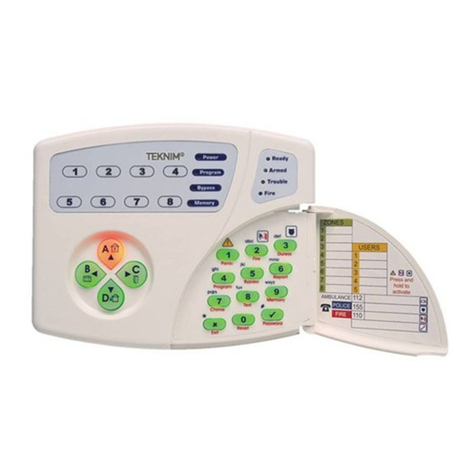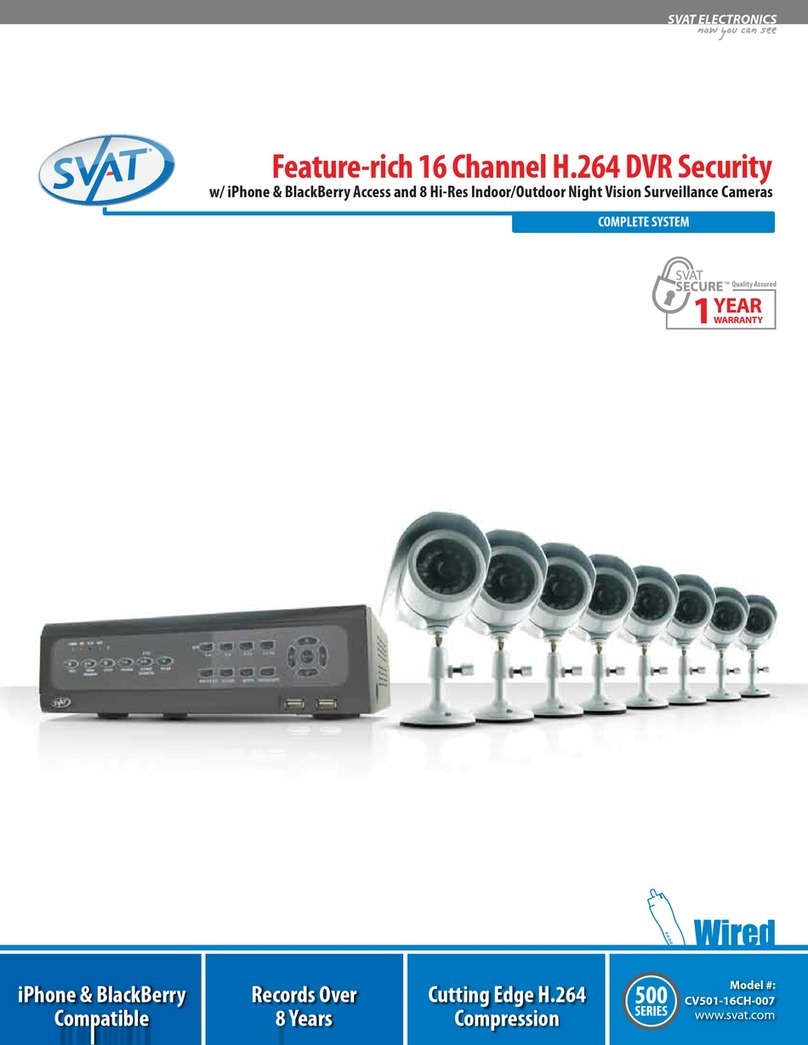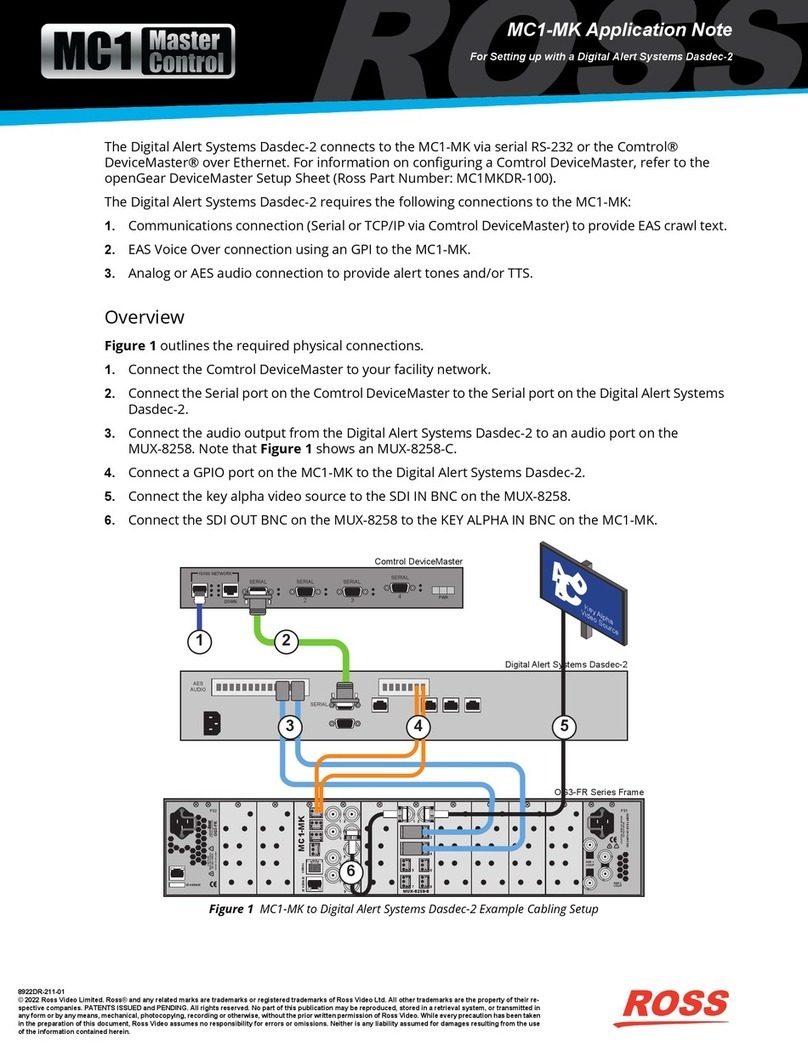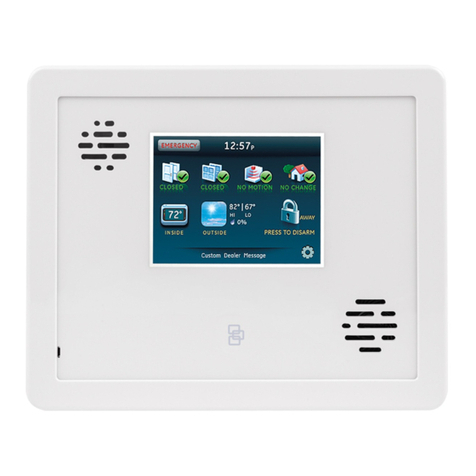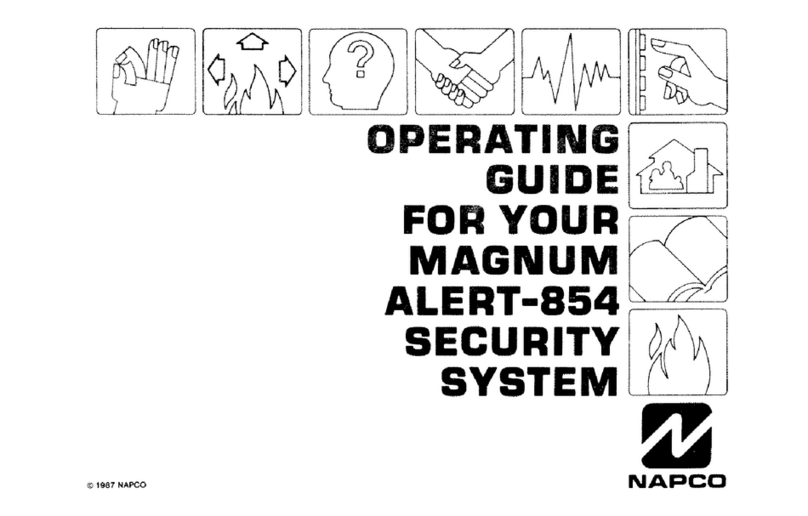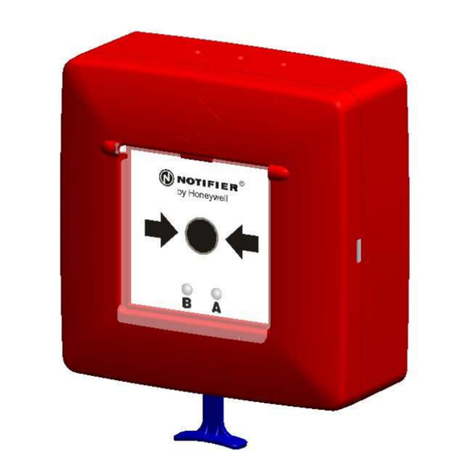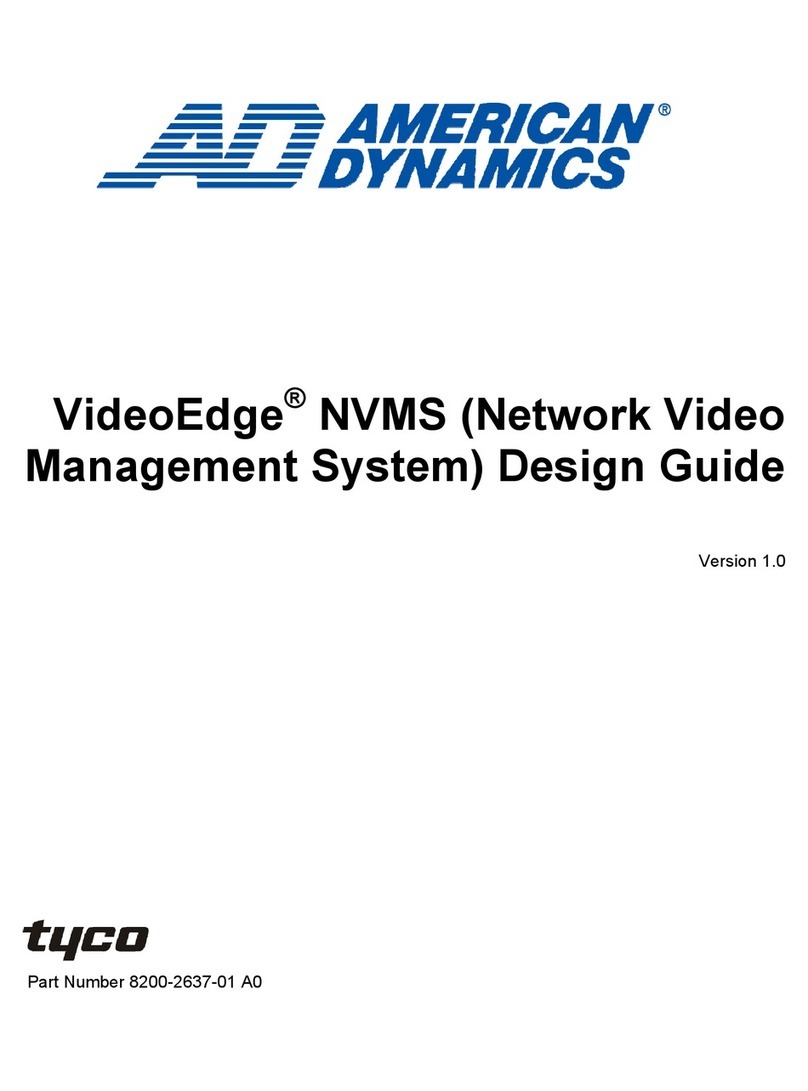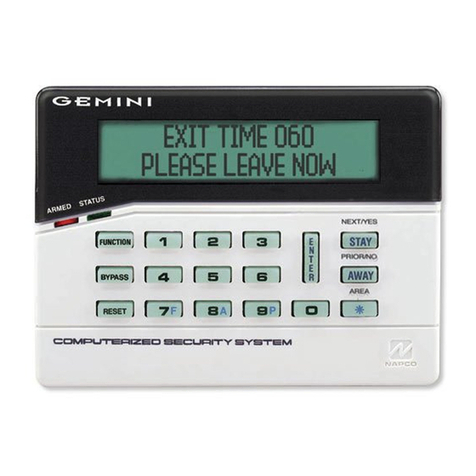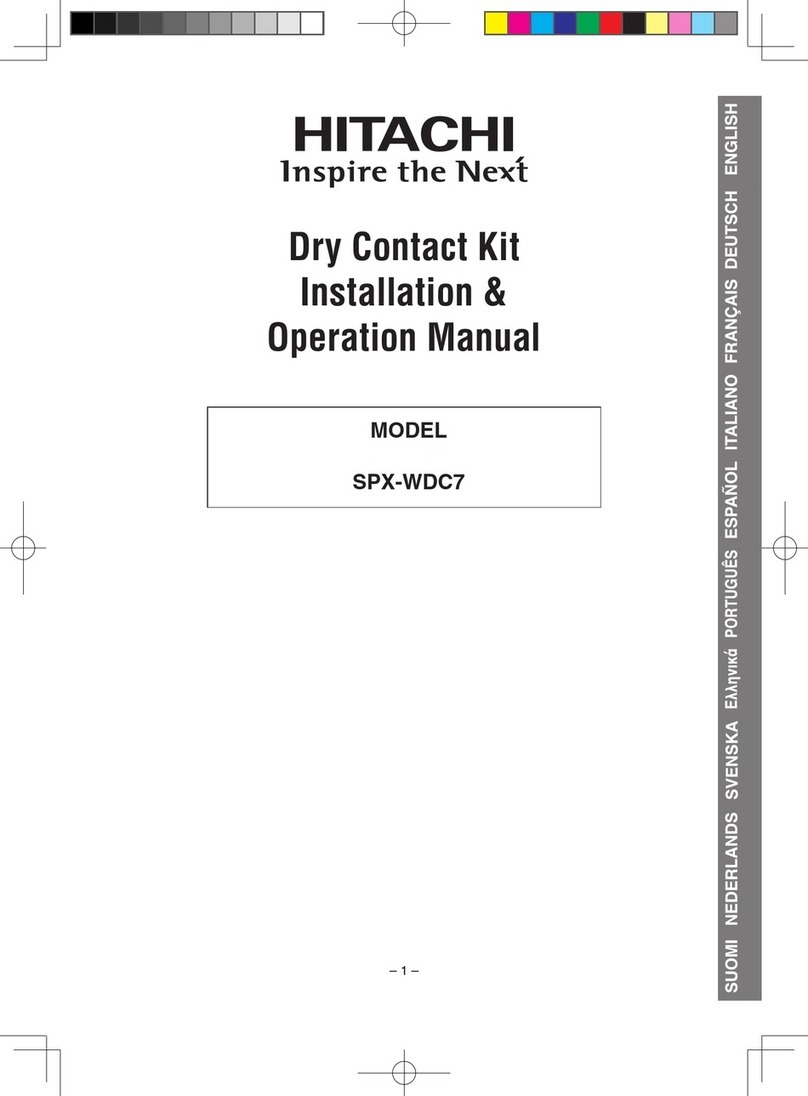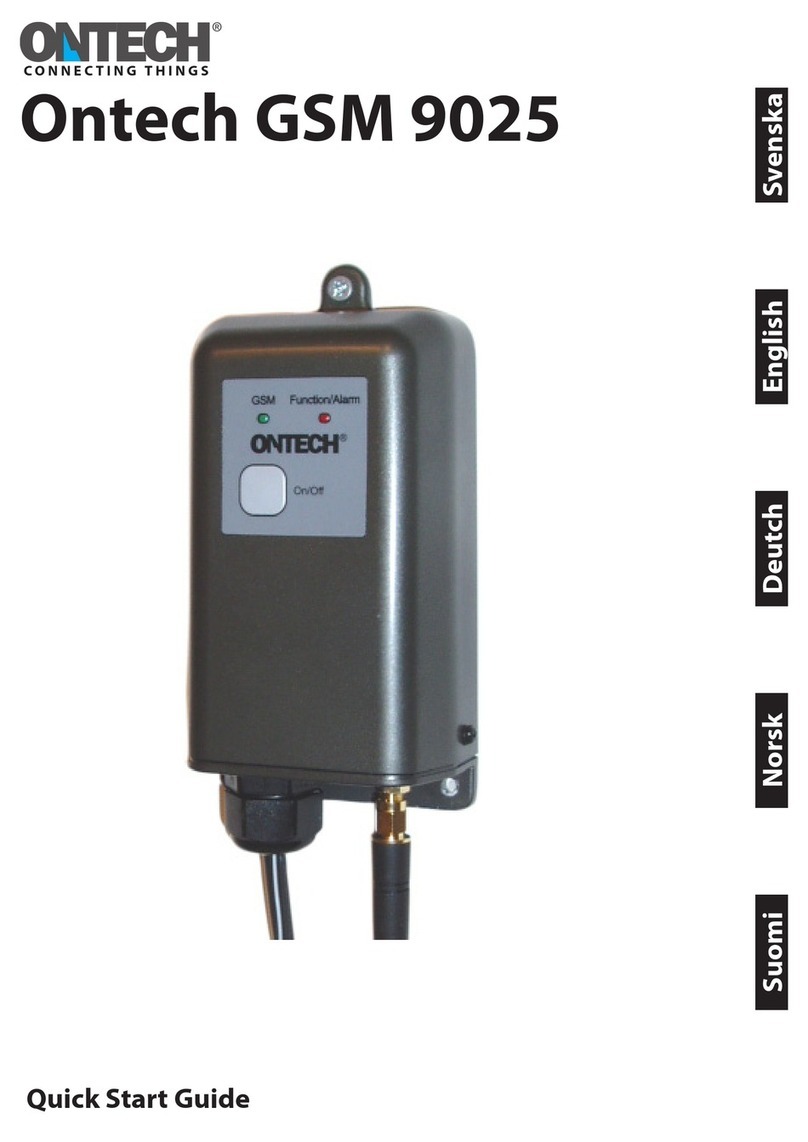Ritron QuickTalk RQT-150 User manual

qtc9322c.pm5
Ritron Publication RQT-UM1 14500006 Rev.I 05-04
Copyright© 2002-2004 RITRON, INC. ALL RIGHTS RESERVED
RITRON , PATRIOT , JOBCOM , Quick Assist , and Quiet Call are registered trademarks of
RITRON, INC. Quick Talk
TM
is a trademark of RITRON, INC.
P.O. Box 1998, Carmel, IN 46082-1998 505 W. Carmel Dr., Carmel, IN 46032 US
PH: 317-846-1201; 800-US -1-US (800-872-1-872) F X: 317-846-4978
E-mail: [email protected]
www.ritron.com
Quick Talk
TM
Wireless Voice Alarm Reporter
Owner's Manual
with Advanced Features Section
CONSTRUCTION
FACTORIES
WAREHOUSES
FARMS
UTILITIES
AIRPORTS
RETAIL STORES
SECURITY
LAW ENFORCEMENT
SHIPPIN
APARTMENTS
SPORTS
HOTELS
RESTAURANTS
SCHOOLS
TRANSPORTATION
Complete
& return the
Warranty Registration
back page
All manuals and user guides at all-guides.com
all-guides.com

qtc9322c.pm5
NOTICE: The Quick Talk unit should not be used to
report conditions relating to safety of life or
property.
To reduce the risk of fire, electric shock or personal
injury, follo these basic safety instructions hen
using this unit.
1. Read and follow all instructions.
2. Disconnect the unit before cleaning. Do not use liquid
or aerosol cleaners.
3. Use only approved power sources for the unit.
4. During thunderstorms avoid contact with this unit and
any external antenna system or wiring.
5. The Quick Talk switch and external power terminals are
connected internally to the antenna connector. If the
Quick Talk switch or power supply terminals contact
high voltage a hazardous condition may exist in that
contacting the antenna could prove injurious or even
fatal.
6. In general the switches you connect to the Quick Talk
are to be independent dry contact switches and not
part of any other "live" electrical circuit
7. If you are unsure whether your installation will be safe
contact an experienced electrician or electronics
technician.
TABLE OF CONTENTS
DESCRIPTION PAGE
WHAT THIS MANUAL COVERS ..................................... ii
WARNINGS AND CAUTIONS .......................................... ii
ACCESSORIES AND OPTIONS ...................................... ii
INTRODUCTION ............................................................ 1
General ............................................................... 1
Model Identification .............................................. 1
FEATURES .................................................................... 1
Basic Features .................................................... 1
Advanced Features ............................................. 1
CONTROLS & CONNECTORS ...................................... 2
PROGRAMMING ........................................................... 3
STANDARD FEATURES ........................................... 3
Frequently Asked Questions ................................ 3
Testing Your Programming Telephone ................ 3
Transmitter Frequency ........................................ 4
Quiet Call Coded Squelch Codes ....................... 5
Digital Quiet Call Squelch Codes ........................ 6
Testing Your Quick Talk ....................................... 6
Setting Narrow/Wide-band Channels ................. 7
Companded Audio Selector ................................ 7
Settings for Battery Type ...................................... 7
Connecting to an External 12 VDC Power
Supply .............................................................. 8
Testing Your Switch ............................................. 9
Recording Voice Messages ................................ 10
Playing Back Voice Messages ............................. 10
Programming Voice Phrase Repetitions ............. 11
Programming a Transmission Schedule ........... 11
Limiting the Number of Transmissions .............. 12
Resetting to Factory Defaults .............................. 12
Using an External Power Supply ......................... 12
Recording a Unique Low Battery Message
to Identify a Quick Talk ..................................... 13
Restarting the Quick Talk when You are
Done Programming ........................................ 13
Connecting to External Power Source ................. 13
ADVANCED FEATURES ............................................. 14
Programming Non-table Transmitter
Frequencies ..................................................... 14
Configure Switch Terminals ................................ 14
Adding a Second Switch to Disable the
Quick Talk Transmitter ..................................... 14
Setting Debounce Options .................................. 15
Monitoring 4-20 mA Sensor Loops ...................... 16
Solar Panels for Operation & Charging ............... 16
Using Latching Option ......................................... 16
Recording Unique Power Failure Messages ...... 18
Enable/Disable Status Messages ....................... 18
Setting Battery Saver Options .............................. 18
INSTALLATION .............................................................. 19
Care and Maintenance ........................................ 19
QUICK REFERENCE GUIDE ............................................ 20
RITRON WIRELESS SOLUTIONS .................................. 22
F.C.C. LICENSING .......................................................... 24
WARRANTY .................................................................. 24
REGISTRATION .................................................. Back Cover
This manual (Ritron Item: RQT-UM1) covers basic oper-
ation of the Quick Talk Wireless Voice Alarm Reporter. For
most applications this is all the information you will need.
More complex features of Quick Talk are explained in the
Advanced Features Section of this manual.
Page ii
WHAT THIS MANUAL COVERS
WARNING
IMPORTANT SAFETY INFORMATION
ACCESSORIES FOR QUICK TALK
These replacement and optional items are available from
Ritron and its authorized dealers.
Item Description
AFB-1545 Standard 16 in. Flexible Whip Antenna
RAM-1545 Magnetic-Mount Antenna w/ 20 ft. of Cable
and a BNC Connector
All manuals and user guides at all-guides.com

Page 1For assistance, call RITRON at 800-872-1872, or go to www.ritron.com
qtm9322b.pm5
ABOUT THE QUICK TALKTM WIRELESS VOICE ALARM REPORTER
QUICK TALKTM WIRELESS VOICE ALARM REPORTER F E AT URE S
GENERAL INFORMATION
The Quick TalkTM is a wireless radio transmitter that
reports changes in the status of switches by transmitting
user-recorded voice messages to two-way mobile,
portable or base station radios. Quick Talk transmits your
voice message when the switch change occurs, and at
intervals you select.
Because you provide and connect the switches, your
Quick Talk units can report on the status of intrusion,
tampering, equipment malfunction, liquid levels, machin-
ery, pressure, temperature, power, smoke or leakage.
The Quick Talk is easily programmed to transmit on either
an existing or a new radio frequency, with the most
popular sub-audible coded squelch formats, such as
Quiet all® or Digital Quiet allTM. This enables all your
personnel with JOB OM®, PATRIOT®, or equivalent two-
way radios to hear the voice messages instantly, and to
be advised of the current condition of each monitored
location or device.
Quick Talk is housed in a weather-resistant enclosure, so
it can be installed in a wide variety of indoor and outdoor
locations. Because its six internal AA Alkaline batteries
will power the unit for about a year, Quick Talk does not
require A line power.
QUICK TALK MODELS AND FREQUENCIES
There are two Quick Talk models, one for each of the most
popular professional radio communications bands. The
model number appears on a label on the front of the case,
and on a second label inside the case.
MODEL BAND FREQUENCY RANGE
RQT-150 VHF-FM 150 to 165 MHz
RQT-450 UHF-FM 450 to 470 MHz
Ritron manufactures mobile, portable and base station
two-way radios and repeaters for use with Quick Talk.
Ritron pioneered the use of olor Dots on radios to
identify frequencies.
Factory-programme , efault Quick Talk frequencies are:
Blue Dot = 154.570 MHz for VHF units;
Blue Star = 467.925 MHz for UHF units.
See page 4 for instructions on changing the Quick Talk
transmit frequency to match an existing radio system.
DESCRIBED IN THE BASIC FEATURES MANUAL:
Internal radio transmitter (separate VHF and UHF models).
User-recorded voice messages; total recording time of 16 seconds.
Terminals for connection to user-supplied switches.
Included external antenna.
Typical range of 1/2 mile. Longer range is possible using an optional antenna.
Weather-resistant (not waterproof nor immersible) enclosure.
Internal battery holder for six (6) AA Alkaline cells.
ompanded Audio - Selectable.
External 12 VD power supply with battery back-up.
Modulation Select for Narow/Wide-band hannels
onnection and use of an external 12 Volt D power supply.
Typical operating battery life of 1 year.
Automatic low battery message.
Limited One-year Factory Warranty.
The following programmable features:
-Transmit Frequency;
-Tone oded Squelch Encoder (Quiet all® Interference Eliminator);
-Digital oded Squelch Encoder (Digital Quiet allTM Interference Eliminator);
-Message transmission schedules and limits.
DESCRIBED IN THE ADVANCED FEATURES SECTION:
Use of the second switch input terminals for messages
Analog voltage (or 4-20 mA loop) inputs
Multiple location identification messages
Terminated alarm loop inputs
Use of solar power panels to operate and charge internal Ni ad batteries
Enabling and disabling the low battery or external power failure messages
Battery saver options
All manuals and user guides at all-guides.com

qtm9322b.pm5
For assistance, call RITRON at 800-872-1872, or go to www.ritron.comPage 2
IDENTIFICATION OF CONTROLS AND CONNECTIONS
1 ANTENNA CONNECTOR
The antenna radiates radio signals. Before using
Quick Talk, make sure the antenna is fastened
securely to this connector. See page 21.
2 TELEPHONE JACK
The modular telephone jack provides temporary con-
nection to a standard pulse or rotary mode telephone
unit, which is used by the owner to program Quick
Assist voice messages and other settings.
WARNING: DO NOT connect the Quick Talk to a line
from the telephone company; doing so
will damage the unit, and void the
manufacturer's warranty.
3 BATTERY HOLDER
The battery holder accommodates the six (6) standard
"AA" alkaline cells required to power the Quick Talk.
NOTE: ALWAYS INSTALL A FRESH SET of alkaline
batteries before programming the unit.
4 SWITCH #1 TERMINALS
These terminals are for connection to a switch the
user supplies. Quick Talk transmits voice messages
determined by the state of this switch.
5 SWITCH #2 TERMINALS
These terminals are for connection to an optional
user-supplied switch. This manual describes how to
use Switch #2 as an On/Off switch to enable or disable
the Quick Talk transmitter, as well as programming
normal debounced and contact closure settings, and
latching mode. Refer to page 9 for details.
6 EXTERNAL POWER TERMINALS
Refer to page 8 for information about connecting an
external 12 Volt D power supply to these terminals.
7 WATERTIGHT STRAIN RELIEF CABLE FITTING
The cable to your external switches passes through
this fitting. When the strain relief fitting is used with
recommended cable sizes, it provides a water-
resistant enclosure. Do not overtighten this fitting.
NOTES: Use Ra io Shack Telephone Station Wire,
6-con uctor, soli 24-AWG In-wall Type CM,
Cat. No. 278-874, or equivalent size round
cable (0.114 0.250 diameter).
If you cannot fin suitable wire, call Ritron
at 800-872-1872.
8 TRANSMITTER BANDWIDTH SELECT JUMPER
DO NOT remove this jumper. As described on page 7,
this jumper controls selection of wide or narrow band-
width.
9 BATTERY TYPE SELECT JUMPER
DO NOT remove this jumper. As described on page 8,
this jumper controls charging of optional Ni- d
batteries.
10. COMPRESSED/NOT-COMPRESSED AUDIO SELECTOR
Do not remove this jumper.
The Quick Talk
can be used with two-way radios that use "companded
audio." For radios with ompanded Audio -place the
jumper in the OMP position. For radios without
ompanded Audio - place the jumper in the NON-
OMP position. To determine if your radio uses
companded audio, call Ritron or your radio supplier.
Refer to page 7.
IMPORTANT:
Do not remove
any other fasteners or
further disassemble the Quick Talk unit; doing so risks
damage to the unit and voiding the manufacturer's warranty.
FIG
-
1: CONTROL & CONNECTION LOCATIONS
2Standard
Modular
Telephone Jack
O
WNER
-
SUPPLIED
S
TANDARD
D
ESK
T
ELEPHONE
S
ET
,
SWITCHED
TO
P
ULSE
D
IALING
M
ODE
OWNER-SUPPLIED M ODULAR
TELEPHONE C ORD:
DO NOT CONNECT TO
TELEPHONE LINE, BUT TO A
TELEPHONE SET ONLY.
TO QUICK TALK
TELEPHONE JACK,
(ITEM 2).
4Switch #1
Terminals
5Switch #2
Terminals
3Battery
Holder
7Customer Service
Push button
Connection
10 Compressed/Not Compressed
Audio Select Jumper
6External Power
Input Terminals
1Antenna Co Axial
to BNC Connector
9Battery Type Selector
8Transmitter Bandwidth
Select Jumper
All manuals and user guides at all-guides.com

Page 3For assistance, call RITRON at 800-872-1872, or go to www.ritron.com
qtm9322b.pm5
FREQUENTLY ASKED QUESTIONS ABOUT QUICK TALK:
Do I have to program my Quick Talk? You may not need
to program your Quick Talk at all. If you purchased a Quick
Talk that is factory-programmed to your radio system
frequency (check the olor Dots on your radios and the
Quick Talk), and you do not use a form of Quiet all coded
squelch, you can connect your switch to the terminals
marked "Switch #1", install the batteries and start using
Quick Talk. The factory default voice messages are
"Switch Open" and "Switch losed". Otherwise, read this
manual, then program your Quick Talk.
Do I nee to program every feature? In many cases, no.
The factory pre-programmed settings, explained in the
instructions, may meet many of your needs.
How o I program my Quick Talk? Quick Talk is designed
to be programmed using a commonly available standard
telephone unit to enter programming information and also
to record custom voice messages. However, the tele-
phone must be both capable of and also switched to
"Pulse" operation. The telephone is used only for pro-
gramming; it is to be disconnected when the Quick Talk is
operating normally.
What if I on't fin what I nee in this manual? all
Ritron; we will be glad to help you. For most applications,
this manual should cover everything you will need to know.
However, the Quick Talk has more capabilities and
features than described here. The Advanced Features
Owner's Manual, or the Application Notes listed on the
inside cover may also be of help. ontact us at Ritron; we
can make Quick Talk do just about anything.
Will it harm the Quick Talk if I program it improperly?
No; however, you may need to erase all programming and
start over; see page 10 to do this. Feel free to experiment
with the various features and possible configurations.
Can my settings or messages get lost or erase if the
battery runs own, or if my Quick Talk is isconnecte ?
No. The settings and voice messages you enter are
stored in special electronic memory devices in the Quick
Talk that do not require power to hold the information. This
means that if the batteries run down or if you remove
them, you will not need to reprogram the unit. All your
settings and messages will be there for you when you
install fresh batteries.
What if I nee more range? To increase the range of your
Quick Talk transmissions, we suggest you first relocate
the unit. Depending on the type of switch and wiring, you
may use several hundred feet of wiring to connect the
switch this allows installation of the Quick Talk and its
attached antenna for the best range, at an unobstructed
and elevated position.
Also, Ritron offers several optional "high gain" antennas.
And, Ritron can provide a ra io repeater to increase the
range not only for your Quick Talk, but also for your entire
radio system.
TEST THE TELEPHONE YOU WILL USE TO PROGRAM THE
QUICK TALK:
A telephone that generates only Touch Tones
CANNOT BE USED to program the Quick Talk.
Most special office telephones, speaker phones, an
telephones with lighte ials usually cannot be use
to program the Quick Talk.
a. Remove the screws from the Quick Talk, then
remove the cover from the unit. Use care to not
damage or disturb any exposed internal compo-
nents.
b. Install six new alkaline "AA" batteries in the Quick
Talk, matching the polarity marks on the batteries
with the marks on the battery holder.
c. Be sure your telephone is capable of "Pulse"
mode. Most modern telephones have a selection
switch for "P" (Pulse) and "T" (Tone). A "Pulse"
mode telephone generates a rapid series of clicks
(rather than Touch Tones) with the input (dialing) of
each digit. If the telephone has this switch, it must
be set to "P" (Pulse) to program the Quick Talk.
d. The telephone must have a cord with a standard
modular plug attached; insert the plug into the
telephone jack in the Quick Talk.
e. Test the telephone for suitability by plugging it into
the Quick Talk's telephone jack and dialing "0"
(Operator). A repeating busy signal in the tele-
phone earpiece indicates it is acceptable for
programming the Quick Talk.
If this telephone oes not check out, try another.
Using the Telephone to Program Quick Talk
Program the Quick Talk by dialing telephone num-
bers representing commands and settings, as this
manual instructs.
If you make a dialing error while programming, hang
up the handset, then pick it up and dial again.
What the Tones (Beeps) in the Telephone Receiver Mean
Quick Talk sounds a brief acknowle gment tone
when you pick up the telephone handset; wait to
hear this tone before you dial.
Quick Talk emits a series of repeating tones until
you hang up, if you mis-dial or if you use an invalid
command; you may then pick up the handset and try
your command again.
Quick Talk responds with a confirmation tone after
you dial command and setting numbers; you may
then either hang up or dial another command.
A series of three short tones cues you to begin
speaking when you dial the command for recording
a voice message into Quick Talk.
PROGRAMMING YOUR QUICK TALK
All manuals and user guides at all-guides.com

qtm9322b.pm5
For assistance, call RITRON at 800-872-1872, or go to www.ritron.comPage 4
What is my Ra io System Frequency? Ritron pioneered
the olor Dot system to simplify the identification of radio
system frequencies for Ritron Jobcom radios. olor Dots
are placed on the bottoms of and inside the enclosures of
all Jobcom radios. Other manufacturers have also
adopted this idea.
To identify your assigned frequency if your radios do not
have a color dot, locate a label identifying the receiver
frequency in megahertz (MHz). Your assigned frequency is
also shown on your F. . . Station License. all your radio
dealer or Ritron for help if you cannot determine your
radio's receiver frequency.
Do I nee to program my Quick Talk's transmitter
frequency? The original factory-programmed transmitter
frequency of your Quick Talk is marked on the outside of
the shipping box, and is also indicated by a color dot on
the inside the unit case. If the Quick Talk frequency
matches your radio system frequency, and if the Quick
Talk has not been reprogrammed since it left the factory,
you may skip this section and proceed to the next.
Note: To program a non-table frequency refer to page 14.
TO PROGRAM THE QUICK TALK TRANSMITTER
FREQUENCY:
a. Determine the frequency of your radio system.
b. Find your frequency in the appropriate table at right,
and determine its corresponding two digit code. If
your radio system frequency is not in the chart, your
Quick Talk must be programmed by a radio dealer
or by Ritron.
c. Pick up the telephone receiver, and listen for the
acknowledge tone. Dial "11", then the digits of the
selected frequency code from the table.
Examples: If the Quick Talk is a VHF RQT-150
model, and the radios operate on
154.570 MHz (Blue Dot frequency),
dial "11-02".
If the Quick Talk is a UHF RQT-450
model, and the radios operate on
467.925 MHz (Blue Star frequency),
dial "11-08".
d. Quick Talk responds with a single beep to indicate
it has programmed the transmitter frequency.
e. You may either hang up or continue programming.
NOTES: If you make a dialing mistake while program-
ming, hang up the telephone handset, then
pick it up and dial again.
If you reprogrammed the Quick Talk frequency,
you may wish to remove the olor Dot from
inside the case, to avoid later confusion.
What the Tones (Beeps) in Your Earpiece Mean:
A series of three short tones cues you to begin
recording a message.
A single brief tone means your command is
accepted and stored.
A series of long repeating tones means your
command was not understood; hang up and dial
again.
UHF Business Ban
Model RQT-450
MHz Frequency Color
QUICK
TALK
FREQ. CODE
01 154.600 .... Green Dot
02 154.570 .... Blue Dot
03 151.625 .... Red Dot
04 151.955 .... Purple Dot
05 151.925
06 154.540
07 154.515
08 154.655
09 151.685
10 151.715
11 151.775
12 151.805
13 151.835
14 151.895
15 154.490
16 151.655
17 151.745
18 151.865
VHF Business Ban
Model RQT-150
MHz Frequency Color
QUICK
TALK
FREQ. CODE
01 467.7625 ..... J
02 467.8125 ..... K
03 464.5500 ..... Yellow Dot
04 464.5000 ..... Brown Dot
05 467.8500 ...... S lver Star
06 467.8750 ...... Gold Star
07 467.9000 ...... Red Star
08 467.9250 ...... Blue Star
09 469.2625
10 462.5750 ...... Wh te Dot
11 462.6250 ...... Black Dot
12 462.6750 ...... Orange Dot
13 464.3250
14 464.8250
15 469.5000
16 469.5500
17 463.2625
18 464.9125
19 464.6000
20 464.7000
TABLE 1: TRANSMIT FREQUENCY CODES
PROGRAMMING YOUR QUICK TALK TRANSMITTER FREQUENCY
(VHF Business B nd)
(UHF Business B nd)
All manuals and user guides at all-guides.com
all-guides.com

Page 5For assistance, call RITRON at 800-872-1872, or go to www.ritron.com
qtm9322b.pm5
QUICK
TALK
QC
CODE
67.0
71.9
74.4
77.0
79.7
82.5
85.4
88.5
91.5
94.8
97.4
100.0
103.5
107.2
110.9
114.8
118.8
123.0
127.3
131.8
136.5
141.3
146.2
151.4
156.7
162.2
XZ
XA
WA
XB
SP
YZ
YA
YB
ZZ
ZA
ZB
1Z
1A
1B
2Z
2A
2B
3Z
3A
3B
4Z
4A
4B
5Z
5A
5B
167.9
173.8
179.9
186.2
192.8
203.5
210.7
218.1
225.7
233.6
241.8
250.3
69.4
159.8
165.5
171.3
177.3
No Tone
183.5
189.9
196.6
199.5
206.5
229.1
254.1
01
02
03
04
05
06
07
08
09
10
11
12
13
14
15
16
17
18
19
20
21
22
23
24
25
26
6Z
6A
6B
7Z
7A
M1
--
--
--
--
--
--
--
--
--
--
--
--
--
--
--
--
--
--
--
QUICK
TALK
QC
CODE
Freq.
( Hz )
Freq.
( Hz )
Other
Radio Brands
Tone
Code
Other
Radio Brands
Tone
Code
* Use Co e "44" to program No Tone for systems without
a oded Squelch Interference Eliminator feature. Refer
to the text at left.
TABLE 2: QUIET CALL TONE CODES
27
28
29
30
31
32
33
34
35
36
37
38
39
40
41
42
43
*44
45
46
47
48
49
50
51
What is Quiet Call Sub Au ible Co e Squelch?
The Quick Talk radio transmitter is compatible with two
standard communications industry sub-audible signaling
formats: Q ® (Quiet all Interference Eliminator), and
DQ TM (Digital Quiet all Interference Eliminator). Both
Quiet all formats unlock receivers programmed to require
these codes -- they screen out interference from other radio
systems operating on your same frequency.
QC® Quiet all is Ritrons trade name for what the
communications industry calls sub-audible (below
the range of human hearing) tone squelch, or
T SS ( ontinuous Tone oded Subaudible
Squelch). Other radio manufacturers use different
trade-names for essentially the same system. You
may program a specific Q code into your Quick
Talk to transmit with the voice messages, which will
"unlock" the receivers in your radio system.
DQCTM Digital Quiet all is Ritrons digital coded squelch,
and works the same as Q , except it is a igital
code that is transmitted with the voice messages.
Do I nee to program my Quick Talk with a Quiet Call
Co e? Your radio system may or may not use coded
squelch signaling. If you have programmed the Quick Talk
to match your radio frequency, and your radios are not
receiving Quick Talk transmissions unless the "monitor" or
"test" button is pressed, your system is probably using
oded Squelch. Refer to your radio manual, or contact
your radio dealer or Ritron if you are unsure about this
issue.
If your Quick Talk was previously programmed with a Quiet
all code and you need to remove it, follow the procedure
below, using No Tone code, "44", as shown in the table.
To Program A Quiet Call Sub-Au ible Squelch Co e:
a. Determine the Quiet all code tone that your radio
system uses. If your system uses Digital Quiet all,
go to the next page.
b. Select the desired Tone ode from Table 2 at right;
write down the code.
NOTE: If your radio system does not use coded
squelch, program No Tone, code, "44".
c. Pick up the telephone receiver and listen for the
acknowledge tone.
d. Dial "21", then the 2-digit Q ode you have
selected.
For example, if your Quiet all frequency is
103.5 Hz ( ode 13), dial: "21-13".
Quick Talk will respond with a confirmation tone.
e. You may either hang up or continue programming
additional features.
PROGRAMMING THE QUIET CALL SUB-AUDIBLE CODED SQUELCH
INTERFERENCE ELIMINATOR
WRITE DOWN your frequency (from page 4), and your QC code (from page 5 or page 6)
Frequency:____________________________ ; QC code: __________________________
All manuals and user guides at all-guides.com

qtm9322b.pm5
For assistance, call RITRON at 800-872-1872, or go to www.ritron.comPage 6
PROGRAMMING DIGITAL QUIET CALL SUB-AUDIBLE CODED SQUELCH
INTERFERENCE ELIMINATOR
What is Digital Quiet Call? Digital Quiet all (DQ ) is a
digital sub-audible coded squelch system.
Do I nee to program my Quick Talk with a Digital Quiet
Call co e? If your radio system does not use Digital Quiet
all, or any other tradename equivalent, skip this section
and go to the next programming feature.
TO PROGRAM A DIGITAL QUIET CALL CODE:
a. Determine the specific Digital Quiet all (DQ ) code
used for your system, then make sure this code is
listed in Table 3, which shows all of the possible
DQ codes for Quick Talk. If your system code is
not listed, call your radio service provider or Ritron.
b. Write down your code.
c. Pick up the telephone receiver, and listen for the
acknowledge tone.
d. Dial "22" followed by the selected 3-digit DQ code.
For example if your DQ code is "131", dial
"22-131".
Wait for the Quick Talk onfirmation Beep.
e. You may either hang up or continue programming.
TABLE 3: DIGITAL QUIET CALL CODES
TEST YOUR QUICK TALK
WIRELESS VOICE ALARM REPORTER
Normal Invert
023 047
025 ........ 244
026 ........ 464
031 ........ 627
032 ........ 051
043 ........ 445
047 ........ 023
051 ........ 032
054 ........ 413
065 ........ 271
071 ........ 306
072 ........ 245
073 ........ 506
074 ........ 174
114 ........ 712
115 ........ 152
116 ........ 754
125 ........ 365
131 ........ 364
132 ........ 546
134 ........ 223
143 ........ 412
152 ........ 115
155 ........ 731
156 ........ 265
162 ........ 503
165 ........ 251
172 ........ 036
Normal Invert
174 ........ 074
205 ........ 263
223 ........ 134
226 ........ 411
243 ........ 351
244 ........ 025
245 ........ 072
251 ........ 165
261 ........ 732
263 ........ 205
265 ........ 156
271 ........ 065
306 ........ 071
311 ........ 664
315 ........ 423
331 ........ 465
343 ........ 532
346 ........ 612
351 ........ 243
364 ........ 131
365 ........ 125
371 ........ 734
411 ........ 226
412 ........ 143
413 ........ 054
423 ........ 315
431 ........ 723
432 ........ 516
Normal Invert
445 ........ 043
464 ........ 026
465 ........ 331
466 ........ 662
503 ........ 162
506 ........ 073
516 ........ 432
532 ........ 343
546 ........ 132
565 ........ 103
606 ........ 631
612 ........ 346
624 ........ 632
627 ........ 031
631 ........ 606
632 ........ 624
654 ........ 743
662 ........ 466
664 ........ 311
703 ........ 565
712 ........ 114
723 ........ 431
731 ........ 155
732 ........ 261
734 ........ 371
743 ........ 654
754 ........ 116
What is the purpose of testing the Quick Talk ra io transmitter?
After following the previous instructions, your Quick Talk will be
programmed to transmit on the same frequency as your radio
receivers, and you also will have programmed your Quick Talk to
transmit any coded squelch signals required for your radio
system.
Do I nee to test my Quick Talk Transmitter? Yes; performing
this test now will save you time and confusion later.
TO TEST THE QUICK TALK RADIO TRANSMITTER:
a. Attach the Quick Talk flexible antenna.
b. Turn on your radio receiver.
c. Momentarily place a screwdriver, paper clip or other
electrically conductive item across the Switch #1 terminals.
d. Quick Talk transmits the losed and Open Switch mes-
sages, which you should be able to hear on your radio
receiver.
If you o not hear the messages, you have probably not
properly programmed the Quick Talk transmitter frequency
or the Quiet all oded Squelch. In this case, repeat the
programming, then perform this test again.
All manuals and user guides at all-guides.com

Page 7For assistance, call RITRON at 800-872-1872, or go to www.ritron.com
qtm9322b.pm5
Some two-way radios have a feature referred to as
companding. It is a way of eliminating background
hiss or noise, making the radio sound clearer.
ompanding is a combination of audio OMPression
in the transmitter and audio exPANDing in the receiver.
The Quick Talk can be set for audio compression by
means of a program jumper. To determine if your existing
2-way radios are using the ompanding feature, you can
check the radios User Manual, contact your radio dealer,
or call Ritron for help.
Not-Compresse : (Refer to FIG-3)
To set the Quick Talk for standard audio or not-
compressed, place the jumper so that the middle pin and
the pin closest to the word NON- OMP are covered by
the jumper.
Compresse : (Refer to FIG-3)
To set the Talk for compressed audio, place the jumper so
that the middle pin and the pin closest to the word OMP
are covered by the jumper.
SETTING NARROW OR WIDE-BAND
CHANNELS
Determine the frequency of your radios. This can be done
by checking with your radio dealer, or if you are using
olor Dot radios, match the color dot to the frequency
table on Page 2. As a general rule, if your frequency has
three or less numbers past the decimal point, your radio
is set for wideband. Example 154.570 MHZ, 462.625 MHz.
If your frequency has more than three numbers past the
decimal point, it is probably set for narrowband. Example:
467.7625 MHz, 467.8125.
Wi e: (Refer to FIG-2)
To set your Quick Talk into wideband position, place the
Transmitter Bandwidth Select Jumper so that both pins of
the 2 pin connector are covered by the jumper.
Narrow: (Refer to FIG-2)
To set your Quick Talk into narrowband position, place
the Transmitter Bandwidth Select Jumper so that only
1 pin of the 2 pin connector is covered by the jumper.
FIG2. J102 SETTING FOR NARROW OR
WIDE-BAND OPERATION
Narrow-Band Wide-Band
CompressedNot-Compressed
FIG3. POSITION FOR NOT-COMPRESSED/
COMPRESSED AUDIO
COMPRESSED/NOT-COMPRESSED
AUDIO SELECTOR JUMPER
I M P O R T A N T
You may change the Transmitter Bandwidth and ompressed/Non-
ompressed Audio jumper settings without re-recording your custom
voice message.
If you are unable to determine if your portable radio uses the
companding feature, we suggest the following:
1. Leave the jumper in the factory default setting NON-COMP.
2. Activate the transmitter of the Quick Talk or Quick Assist (I or II)
and listen to the message from your portable radio. If the
received audio is acceptable, skip the rest of this section, if its
not acceptable continue to step #3.
3. hange the jumper setting to the COMP position and activate
the Quick Talk or Quick Assist (I or II) transmitter again, and
listen to the voice message.
Place the jumper in the setting that produces the best
received audio message in the radio you will be using.
All manuals and user guides at all-guides.com

qtm9322b.pm5
For assistance, call RITRON at 800-872-1872, or go to www.ritron.comPage 8
NOTE: When programming, use either fresh Alkaline
batteries (or an external power supply), to power
the Quick Talk. When programming is finishe ,
you may either insert Ni- d batteries or leave
Alkaline batteries in place.
WARNING: DO NOT attempt to charge Alkaline
batteries from an external +12 VDC
power supply.
When powering Quick Talk with ALKALINE BATTERIES,
set J103 as follows to disconnect the charging current
paths:
a. To set the Quick Talk for use with alkaline batteries,
move Jumper J103 to cover only one pin of the jumper
base, as shown in FIG-4; this setting prevents the
flow of charging current.
b. Dial "943" to program the Quick Talk for use with
alkaline batteries.
When powering Quick Talk with NI-CD BATTERIES,
set J103 as follows to connect the charging current
paths:
c. over both pins with Jumper J103, as shown in FIG-
4, to charge the Ni- d batteries from the External
Power connection.
d. Dial "944" to adjust the Quick Talk voltage; the unit
then transmits a "Low Battery" phrase.
NOTE: Because Ni-C batteries self- ischarge rapi ly,
you must constantly charge them with an
external +12 VDC power.
J103 JUMPER SETTINGS
FOR BATTERY TYPE
FIG4. J103 POSITION FOR USE WITH
ALKALINE OR NI-CD BATTERIES
Alkaline NI-CD
CONNECTING AN EXTERNAL
12 VDC POWER SUPPLY
FIG5. EXTERNAL POWER SUPPLY
CONNECTIONS
SWITCH 1
EXTERNAL POWER
SUPPLY
+
-
TO CONNECT AN EXTERNAL 12 VDC POWER SUPPLY:
The standard Quick Talk may be used with an external
12 VD power supply.
Instructions:
1. Route the power supply cable trough the Ritron
#02500127 strain relief fitting as described in FIG-7
on page 14.
2. Use Ritron #RPS-203 Power Supply (11-15 VD ,
200 mA), or equivalent, to power the Quick Talk.
The Quick Talk requires 11-15 VD , 150 mA
minimum.
3. onnect the positive (+) terminal of the power supply
cable to the +EXT. PWR screw terminal on the Quick
Talk, refer to FIG-5.
4. onnect the negative (-) terminal of the power supply
cable to the -EXT. PWR screw terminal on the Quick
Talk, refer to FIG-5.
All manuals and user guides at all-guides.com

Page 9For assistance, call RITRON at 800-872-1872, or go to www.ritron.com
qtm9322b.pm5
TEST YOUR SWITCH'S OPEN AND CLOSED CONDITIONS
Talk according to the polarity marks.
4. Activate your switch; listen to your two-way radio as
the factory default messages are transmitted. (The
message will be either "Switch One Open" or
"Switch One losed".)
Write down a description of how the condition of
your switch corresponds to the transmitted mes-
sage. Then deactivate the switch and listen to the
other transmitted message; again, write down the
results.
5. From performing Step 4, above, you should
understand how your switch works, and the
meaning of its open and closed states essential
knowledge to program a descriptive voice mes-
sage for each switch condition.
For example, if your switch is a magnetic reed
switch on a door, and the switch closes when the
door is opened, you can record the phrase "Door
three open" for the switch closed condition, and
then "Door three closed" for the switch open
condition. Note that magnetic reed switches are
available which work in the opposite way.
NOTE: We suggest that you o not recor over the
factory prerecorded messages until you are
sure how your switch works. If the factory-
programmed messages have been erased,
you will have to use an electrician's continuity
tester or similar instrument to determine
how your switch works.
What is the purpose of testing my switch? In Quick
Talk's basic operating mode, you may record two (2) voice
messages for the Quick Talk to transmit. One message
is transmitted when the switch is Opened and the other is
transmitted when the switch is losed. Each message
must be eight (8) seconds or less in length.
Before you record these switch condition messages,
determine how your switch works by using the factory
prerecorded messages in the Quick Talk. After you have
programmed the Quick Talk with your radio system
frequency and with any required sub-audible squelch
codes, use the following procedure.
Do I nee to test my switch? If you are certain of the
conditions which cause your switch to open and close,
you do not need to perform this test. However, we
recommend you do test your switch, because doing so
will confirm you have properly programmed the Quick Talk
transmitter frequency and, if required for your radio
system, the Quiet all Interference Eliminator squelch
code.
To Test Your Switch an Verify Reception of Messages
by Your Ra ios
1. Remove the batteries from the holder.
2. Review the safety precautions on Page ii of this
manual before connecting your switches. When
you are sure your connections will be safe,
connect your switch to the Quick Talk terminals
labele Switch #1. See FIG-6 below.
3. Reinstall fresh AA Alkaline batteries in the Quick
FIGURE 6: CONNECTIONS FOR TESTING YOUR SWITCH
CONNECT THE STANDARD
MODULAR PLUG ONLY
TO A TELEPHONE SET.
DO NOT CONNECT IT TO
A TELEPHONE LINE.
TO QUICK TALK
TELEPHONE JACK
Owner Supplied Standard
Desk Telephone, switched to
Pulse Dialing Mode
1Antenna Connection
(Antenna shown on page 12)
Battery Holder
F
ACTORY
S
HORTING
J
UMPER
(Enables Quick Talk; see page 11)
Connect to
switch #1
terminals
External Power
(+)
(-)
Switch #2
Terminals
Connect the standard Modular Plug only
to a telephone set. Do not connect it to
a telephone line.
All manuals and user guides at all-guides.com
all-guides.com

qtm9322b.pm5
For assistance, call RITRON at 800-872-1872, or go to www.ritron.comPage 10
RECORDING VOICE PHRASES FOR YOUR SWITCH CONDITIONS
PLAYING BACK THE OPEN AND CLOSED VOICE PHRASES
FOR YOUR SWITCH CONDITIONS
What is the purpose of Recor ing Voice Phrases?
Recording customized voice phrases gives Quick Talk
messages unmistakable meaning and significance. The
standard factory prerecorded messages of "Switch Open"
and "Switch losed" require the listener to know how the
switch works and what it does. However, when a user
hears a custom message such as "Water pump three
running hot", the meaning is clear.
Do I nee to program Voice Phrases? If the factory-
recorded messages "Switch Open" and "Switch losed"
suit your application, you may skip this section.
Your recorded voice message will sound only as good as
the telephone set you use. If your message has the audio
too low, record it again, speaking louder. If your message
is distorted, record it again, speaking softer. If you are
dissatisfied with the audio quality, try a different telephone
set.
When the Quick Talk is transmitting, it draws maximum
power from the battery, and can also interfere with other
transmissions. Therefore, when you record a voice phrase,
hang up when you are finished speaking. Otherwise, the
Quick Talk transmitter will be on for the full eight seconds,
regardless of the actual message length.
To Recor Your Switch Open Con ition Phrase
a. Pick up the telephone receiver, wait for the beep
and dial "311".
Quick Talk sounds three short tones to prompt you
to begin speaking . . .
b. Record a phrase no longer than eight seconds,
describing the open condition of your switch.
Example: "Pump motor temperature OK".
c. Hang up the telephone when you complete your
phrase.
d. Pick up the telephone and dial "411". Your phrase
will be played back through the telephone receiver.
e. Return to Step a above and record again if you are
not pleased with the results.
To Recor Your Switch CLOSED Con ition Phrase
a. Pick up the telephone receiver, wait for the beep
and dial "312".
Quick Talk sounds three tones to prompt you to
begin speaking . . .
b. Record a phrase no longer than eight seconds,
describing the closed condition of your switch.
Example: "Pump motor over temperature".
c. Hang up the telephone when you complete your
phrase.
d. Pick up the telephone and dial "412". Your phrase
will be played back through the telephone receiver.
e. Return to Step a above and record again if you are
not pleased with the results.
To Play Back the Switch Open Con ition Phrase
a. Pick up the telephone.
b. After the tone, dial "411". Quick Talk plays the
Switch Open condition phrase.
Example: "Pump motor temperature OK".
c. Wait for the confirmation beep, then hang up the
telephone, or continue programming.
To Play Back the Switch Close Con ition Phrase
a. Pick up the telephone.
b. After the tone, dial "412". Quick Talk plays the
Switch losed condition phrase.
Example: "Pump motor running hot".
c. Wait for the confirmation beep, then hang up the
telephone, or continue programming.
All manuals and user guides at all-guides.com

Page 11For assistance, call RITRON at 800-872-1872, or go to www.ritron.com
qtm9322b.pm5
PROGRAMMING HOW MANY TIMES YOUR
RECORDED VOICE PHRASES ARE
REPEATED IN EACH TRANSMISSION
PROGRAMMING A BROADCAST
SCHEDULE FOR SWITCH STATUS
TRANSMISSIONS
What is the purpose of programming a Broa cast
Sche ule for Switch Status Transmissions? You can
program different switch status transmission schedules for
the open condition, and for the closed condition of your
switch.
Example: The switch status message for switch
open is "Pump motor temperature OK". You may
schedule the Quick Talk to transmit this message
once every two hours; this way, you know the Quick
Talk is operating properly.
If the corresponding switch status message for switch
close is "Pump Motor Over Temperature", you may
schedule the Quick Talk to broadcast this message
every two minutes, so the situation would receive
prompt attention.
Do I nee to program this feature? The Quick Talk is
set at the factory to transmit a switch status message one
time with each switch change. If this is sufficient for your
application, you can skip to the next section.
To Program a Broa cast Sche ule of Switch Status
Transmissions for the Switch Open Con ition:
1. Pick up the telephone receiver; listen for the tone.
2. Dial "511", then dial the one-digit code number from
Table 5 below.
The Factory Default is "511-1", which means the
transmission is sent one time when the switch
changes to open condition.
Wait for the confirmation beep after dialing.
3. Hang up the telephone or continue programming.
To Program a Broa cast Sche ule of Switch Status
Transmissions for the Switch Close Con ition:
1. Pick up the telephone receiver; listen for the tone.
2. Dial "512", then the one-digit code number from
Table 5.
The Factory Default is "512-1", which means the
transmission is sent one time when the switch
changes to closed condition.
Wait for the confirmation beep after dialing.
3. Hang up the telephone or continue programming.
What is the purpose of setting the number of times the
Voice Phrase is repeate in each Transmission? Your
previously recorded voice phrase can be programmed to
repeat from one time to nine times in each Quick Talk radio
transmission, depending on how you program this feature.
More urgent messages may have more phrase repeats.
Example: You previously recorded the message "Pump
Motor Hot", then programmed Quick Talk to repeat the
phrase two (2) times in each transmission. In this case,
activating the switch results in the Quick Talk transmitting:
"...beep. Pump motor hot. Pump motor hot. beep..."
The beginning and ending beeps are added automatically
to attract attention to Quick Talk transmissions.
Do I nee to program this feature? The Quick Talk is
set at the factory to play each recorded voice phrase one
time in each transmission. If this is sufficient for your
application, you can skip to the next section, in which we
explain how to program the transmission itself to be
repeated at different intervals.
To Program the Number of Times the Switch Open
Phrase is Repeate in Each Transmission:
1. Pick up the telephone receiver; listen for the tone.
2. Dial "711" then a single digit indicating how many
times you want the voice phrase repeated in each
transmission, as shown in Table 4.
Example: To repeat the phrase three times, dial
"711-3".
Wait for the confirmation tone after dialing.
3. Hang up the telephone or continue programming.
To Program the Number of Times the Switch Close
Phrase is Repeate in Each Transmission:
1. Pick up the telephone receiver, listen for the tone.
2. Dial "712", then a single digit indicating how many
times you want the voice phrase repeated in each
transmission, as shown in Table 4.
Example: To repeat the phrase five times, dial
"712-5".
Wait for the confirmation tone after dialing.
3. Hang up the telephone or continue programming.
TABLE 4
VOICE PHRASE REPEATS CODE
IN EACH TRANSMISSION NUMBER
1 time
.............................
1
2 times
............................
2
3 times
............................
3
4 times
............................
4
5 times
............................
5
6 times
............................
6
7 times
............................
7
8 times
............................
8
9 times
............................
9
TABLE 5
CODE
MESSAGE SCHEDULE NUMBER
Never send messages for this condition
....
0
On switch condition change only
........
1
Every 30 seconds
.....................
2
Every (1) minute
......................
3
Every (2) minutes
.....................
4
Every (5) minutes
.....................
5
Every (10) minutes
....................
6
Every (30) minutes
....................
7
Every (1) hour
........................
8
Every (2) hours
.......................
9
DEFAULT
DEFAULT
All manuals and user guides at all-guides.com

qtm9322b.pm5
For assistance, call RITRON at 800-872-1872, or go to www.ritron.comPage 12
Set Sche ule Message Repeat Limit for Switch Open
a. From Table 6 below, select the code number for the
desired number of messages.
b. Lift the telephone receiver and dial "611", then dial
the selected ode Number.
Quick Talk responds with the single confirmation
tone.
c. You may either hang up or continue programming.
Set Sche ule Message Repeat Limit for Switch Close
a. From Table 6 below, select the code number for the
desired number of messages.
b. Lift the telephone receiver and dial "612", then dial
the selected ode Number.
Quick Talk responds with the single confirmation
tone.
c. You may either hang up or continue programming.
What is the purpose of limiting the number of times a
sche ule voice message is transmitte ? In the
previous section, you have programmed the Quick Talk to
transmit a switch status message at regular intervals. In
this section, you can set a limit to the number of times the
message will be transmitted at the scheduled intervals.
Example: Suppose you have a vehicle detector switch
that closes when it detects a vehicle at the delivery
door of your building. Your recorded message might
then be "Vehicle at Delivery Door". You may want this
message to be transmitted every two minutes for
approximately a quarter hour after a vehicle is de-
tected, then to stop transmitting until the vehicle is
moved. In this case, you would program the message
schedule (in the previous section of this manual), for
every two minutes, and set the message limit to "8", as
described here.
When a vehicle arrives, the switch closes and the
message is transmitted every 2 minutes until it has
been sent 8 times over a span of 16 minutes, unless
the vehicle leaves before 16 minutes has lapsed. In this
case, the switch opens and the message ceases when
the vehicle is moved.
When another vehicle arrives, the Quick Talk again
transmits the message every two minutes for about a
quarter of an hour, or until the vehicle leaves.
Do I nee to program this feature? The Quick Talk is set
at the factory to transmit switch status messages without
limit. For example, if you programmed the Quick Talk to
transmit a status message every hour, it would continue to
do so until the battery runs down. If this programming is
sufficient for your application, you can skip to the next
section.
PROGRAMMING A LIMIT TO THE NUMBER OF SCHEDULED TRANSMISSIONS
TO ERASE AND REPROGRAM THE
UICK TALK TO
ORIGINAL FACTORY SETTINGS
What is the purpose of erasing an reprogramming the
Quick Talk to its original factory settings? You can
erase all your programming to return Quick Talk to its
Factory Default Settings with this command.
NOTE: Th s command does not restore the Factory Default
recorded vo ce messages. Any recorded messages may
be lost by use of th s command; you w ll have to record
them aga n, us ng the nstruct ons n th s manual.
Do I nee to use this feature? If you are unsure how the
Quick Talk features are programmed, and want to start
over again, use this feature.
To Erase an Reprogram the Quick Talk Settings as
Originally Factory Programme :
a. Pick up the telephone receiver, wait for the ac-
knowledgment tone.
b. If your Quick Talk is a VHF-FM RQT-150 model,
dial "978", OR
If your Quick Talk is a UHF-FM RQT-450 model,
dial "979".
c. After you hear the confirmation tone, hang up the
telephone.
d. Play back your voice phrases and re-record them
as necessary.
TABLE 6
MESSAGE SCHEDULED CODE
REPEAT LIMIT NUMBER
1 time
.............................
1
2 times
............................
2
3 times
............................
3
4 times
............................
4
5 times
............................
5
6 times
............................
6
7 times
............................
7
8 times
............................
8
Repeat Forever, No Limit
............
9
DEFAULT
USING AN EXTERNAL
POWER SUPPLY
If an external 12VD power supply is used, route the
power supply cable through the strain relief fitting. Refer to
FIG-8 on Page 13.
onnect the positive(+) terminal of the power supply cable
to the +EXT. PWR screw terminal on the Quick Talk (refer
to Page 8 for location).
onnect the negative(-) terminal of the power supply cable
to the -EXT. PWR screw terminal on the Quick Talk (refer
to Page 8 for location).
All manuals and user guides at all-guides.com

Page 13For assistance, call RITRON at 800-872-1872, or go to www.ritron.com
qtm9322b.pm5
What is the purpose of recor ing a unique Voice Phrase
for the Low Battery Message? When it senses the
installed batteries are nearly run down, Quick Talk will
transmit one time each hour the factory-programmed
message: "Low Battery". If you maintain several Quick
Talk transmitters within radio range of each other, you may
customize this feature to easily determine which unit
needs new batteries.
Do I nee to program this feature? If you use only one
Quick Talk in any area, or if you regularly change Quick
Talk batteries, the factory-programmed message may be
sufficient for your application. You can skip to the next
section.
To Program the Low Battery Alert Phrase:
a. Pick up the telephone receiver, wait for the beep,
then dial "35".
Quick Talk sounds three short tones to prompt you
to begin speaking . . .
b. Record a phrase no longer than one and one-half
(1.5) seconds, indicating Low Battery, and identify-
ing the Quick Talk unit.
For example say: "Low Battery Five".
c. Hang up the telephone when you are done speak-
ing.
d. Pick up the telephone and dial "45" to hear your
phrase played back through the telephone receiver.
e. If you are not pleased with the results, you may
return to Step a above and record again.
NOTE: We suggest you physically mark the Quick
Talk with the same unique identifier
(number) you recorded.
RECORDING A UNI UE LOW BATTERY
MESSAGE TO IDENTIFY A UICK TALK
What is the purpose of restarting the Quick Talk? If you
have changed message schedules or limits, restarting the
Quick Talk ensures that all of internal clocks and counters
are set properly.
Do I nee to restart the Quick Talk? It is best if you do.
To Leave Telephone Programming Mo e an Restart the
Quick Talk:
Pick up the telephone receiver, wait for the beep
and dial "999".
Quick Talk responds with a single short tone.
NOTE: Be certain to hang up and to disconnect the
telephone from Quick Talk.
RESTART THE UICK TALK WHEN YOU
ARE DONE PROGRAMMING
All manuals and user guides at all-guides.com

Page 14 For assistance, call RITRON at 800-872-1872, or go to www.ritron.com
ONE SWITCH INPUT TERMINAL:
a. Pick up the telephone receiver and listen for the
acknowledge tone.
b. Dial "911". Quick Talk responds with a confirmation
tone.
TWO SWITCH INPUT TERMINALS:
a. Pick up the telephone receiver and listen for the
acknowledge tone.
b. Dial "912". Quick Talk responds with a confirmation
tone.
NOTE: If you change f om one input te minal to two,
o f om two input te minals to one, eco d all
new messages. The way messages are stored
and the time available for each message differs
between the two modes.
What is the pu pose adding a second switch to disable
the Quick Talk? There may be times you want the Quick
Talk to
not t ansmit messages
.
For example, if Quick Talk reports the status of an entry
door for the night shift, you may wish to not hear status
messages all day. se the second switch to enable the
Quick Talk at night, and disable it during the day.
Add a second switch to disable Quick Talk Messaging:
a. Remove the shorting jumper from the Switch #2
terminals.
b. Connect an external switch to the terminals marked
Switch #2.
NOTES:Switch #2 in On/ OFF mode, as described
here, is a feature of Switch #1 operation. Dial
911 to put Quick Talk into this mode.
When Switch #2 is closed, Quick Talk
functions normally. When Switch #2 is open,
Quick Talk is disabled and will not transmit
messages.
When Switch #2 has been open (Quick Talk
disabled), and it is then closed, Quick Talk
transmits the prerecorded message describ-
ing the current condition of Switch #1.
If you do not need to add a second switch, see the
next section.
3. ADDING A SECOND SWITCH
TO DISABLE THE QUICK
TALK TRANSMITTER
2. CONFIGURE SWITCH
TERMINALS
Q
UICK
T
ALK
A
DVANCED
F
EATURES
1. PROGRAMMING NON-TABLE
TRANSMITTER FREQUENCIES
TO PROGRAM A FREQUENCY THAT IS NOT LISTED IN
TABLE 1 ON PAGE 4.
1. Review the basic information in the manual.
2. Connect the telephone as shown.
3. Install six (6) new AA alkaline batteries as shown
4. Lift the telephone receiver and listen for the
acknowledgement beep.
5. Dial 12 followed by the first six (6) digits of the desired
frequency. DO NOT dial the seventh (7th) digit of a narrow
bandwith (12.5 kHz) frequency. The Quick Talk will
respond with a confirmation tone.
6. Hang up the telephone if you make a mistake, and start
over.
7. When you are finished programming, test the unit as
described on page 6.
All manuals and user guides at all-guides.com
all-guides.com

For assistance, call RITRON at 800-872-1872, or go to www.ritron.com Page 15
2. HOLDOFF DEBOUNCE option transmits messages
immediately upon change of switch condition, and will
also hold off a message of further change for the time
period of the selected debounce.
EXAMPLE: A Quick Talk is used as a gate doorbell. It is
practical for the message to be transmitted
immediately, and also desirable to have a
one-minute debounce before the same
message is re-sent, even if the button is
pushed repeatedly.
TO USE SWITCH 1 AS A NORMAL HOLDOFF
CONTACT CLOSURE:
a. Pick up the telephone receiver and listen for the
acknowledge tone.
b. Dial "5110" to suppress the phrase for Switch 1 OPEN,
and to prevent message transmission for the button
being pressed.
b. Select the code for the desired Holdoff time from Table 8
below.
c. Dial "813x", "x" being the selected code from Table 8,
below. A beep indicates the command is accepted.
NOTE: For the gate doorbell example above, dial
"8134" for 1-minute holdoff.
d. To complete the programming, dial "999", wait for the
beep, then hang up the telephone.
TO USE SWITCH 2 AS A NORMAL HOLDOFF
CONTACT CLOSURE:
a. Pick up the telephone receiver and listen for the
acknowledge tone.
b. Dial "5210" to suppress the phrase for Switch 2 OPEN,
and to prevent message transmission for the button
being pressed.
b. Select the code for the desired Holdoff time from Table 8
below.
c. Dial "823x", "x" being the selected code from Table 8,
below. A beep indicates the command is accepted.
d. To complete the programming, dial "999, wait for the
beep, then hang up the telephone.
4. SETTING DEBOUNCE OPTIONS
1. NORMAL DEBOUNCE is an option specifying that the
switch must remain in its changed condition for a user-
specified time period ("debounce"), before generating a
message for the changed condition.
EXAMPLE: A sensor is used to detect a car in a "No
Parking" zone. Since it is undesirable for a
message to be generated by normal traffic
through the "No Parking" zone, a five-minute
Normal Debounce is used. Only if the sensor
is activated for a full five minutes will the "car
illegally parked" message be transmitted.
TO USE SWITCH 1 AS A NORMAL DEBOUNCED
CONTACT CLOSURE:
a. Pick up the telephone receiver and listen for the ac-
knowledge tone.
b. Select the code for the desired Debounce time from
Table 7 below.
c. Dial "812x", "x" being the selected code from Table 7,
below. A beep indicates the command is accepted.
NOTE: For the "No Parking" zone example above,
dial "8126" for 5-minute debounce.
d. To complete the programming, dial "999", wait for the
beep, then hang up the telephone.
TO USE SWITCH 2 AS A NORMAL DEBOUNCED
CONTACT CLOSURE:
a. Pick up the telephone receiver and listen for the ac-
knowledge tone.
b. Select the code for the desired Debounce time from
Table 2, below.
c. Dial "822x", "x" being the selected code from Table 7,
below. A beep indicates the command is accepted.
d. To complete the programming, dial "999, wait for the
beep, then hang up the telephone.
There are two modes of contact debounce;
1. No mal Debounce, and 2. Holdoff Debounce:
-
DEFAULT
DEBOUNCE TIME CODE
NUMBER
No Debounce
.....................
1
10 seconds
........................
2
30 seconds
........................
3
1 minute
...........................
4
3 minutes
.........................
5
5 minutes
.........................
6
HOLDOFF TIME CODE
NUMBER
No Holdoff
.........................
1
10 seconds
........................
2
30 seconds
........................
3
1 minute
...........................
4
3 minutes
.........................
5
5 minutes
.........................
6
-
DEFAULT
TABLE 7
TABLE 8
Q
UICK
T
ALK
A
DVANCED
F
EATURES
All manuals and user guides at all-guides.com

Page 16 For assistance, call RITRON at 800-872-1872, or go to www.ritron.com
FIG8. CURRENT LOOP
(EXAMPLE CONNECTION DIAGRAM)
5. MONITORING 4 - 20 mA
SENSOR CURRENT LOOPS
W/ ANALOG MODES
TO USE QUICK TALK TO MONITOR 4-20 mA
SENSOR CURRENT LOOPS WIT ANALOG INPUT
MODES
Quick Talk can act as a current sink after a resistor is
connected between the Switch 1 positive and negative
terminals. The resistance value is selected to scale the
current to the permitted 0 - 5 Voltage range for the Switch 1
input to Quick Talk. See the following formula, and Fig8.
5 Volts (max. permitted Voltage)
--------------------------------------------------------- = 250 Ohms
20 mA (max. current from sensor loop) of resistance
NOTES:
sing a lower resistance value with the 4-20 mA
current loop produces less than 5 V at the Switch
1 input; since the full 5 Volt range is not used,
measurement resolution is reduced.
sing a higher resistance value at 20 mA
produces greater than 5V at the Switch 1 input,
which risks damaging the Quick Talk unit.
6. SOLAR PANELS FOR
OPERATING & CHARGING
NI-CD BATTERIES
TO USE SOLAR POWER PANELS FOR OPERATION
AND FOR CHARGING INTERNAL NI-CD BATTERIES:
Follow the instructions on page 8 for using Ni-Cd batteries,
including Step c. to enable the Battery Saver, and d. to
minimize the charging current needed. DO NOT EXCEED
15 Volts at the exte nal batte y te minals.
CALCULATING T E SOLAR PANEL SIZE:
Quick Talk uses little power when it is not transmitting. The
estimated time the unit does transmit can accurately
determine solar panel size requirements to charge Ni-Cd
batteries. The following formula sizes the panel properly:
EXAMPLE: Assume the Quick Talk t ansmits fo one
minute of eve y hou , on ave age (1/60 hou ).
Fu the assume the Quick Talk d aws 150 mA
of cu ent while t ansmitting (150 mA).
NOTE: 150 mA is a bit higher than real consumption; the
panel will be slightly oversized.
The formula to calculate required mA hours:
(1/60 hr.) x (150 mA) x ( No. of hours ) = Req'd. mA hr./
day
operation/ day
Plug the Example into the Formula:
(1/60 hour) (150mA) (24 hours/ day) = 60 mA hours/ day
RESULTS: In this Example, the Quick Talk solar panel
supplies 60 mA-hours in a 24-hour period.
NOTE:Study solar panel manufacturers' information.
TO USE LATC ING MODE:
se the Quick Talk latching mode application if repeated
transmissions are desired with a momentary switch (i.e.:
a push-button). The latching effect maintains message
repeats after the momentary switch change has ended.
EXAMPLE: To use a Quick Talk in a paint department, set it
to repeat phrase transmissions after the "Press
for Help" push-button is activated. In this
example, the recorded phrase transmits every 2
minutes until the Quick Talk latch mode resets
(an employee resets Switch 2).
TO PROGRAM LATCHING MODE:
NOTE: This example uses a No mally Open switch.
a. Pick up the telephone receiver and listen for the
acknowledge tone.
NOTE: To remove possible interference from prior
programming, in this application it is best to
use a Quick Talk unit set to factory defaults.
To esto e facto y defaults:
Dial "978" fo VHF units; dial "979" fo UHF units.
To p og am a diffe ent f equency than the default,
refer to page 7.
b. If you have a Normally Open switch, dial "814" to latch
the CLOSED condition on Switch 1. A beep indicates
the command is accepted.
. USING LATCHING OPTION c. Dial "312". Quick Talk sounds three short tones to
prompt you to begin speaking, then record the Switch 1
phrase, to be no longer than eight seconds.
EXAMPLE: Record "Help needed Paint Department."
d. Dial "5110" to suppress the Switch 1 OPEN message
(preventing transmitted messages when the sales
person resets the unit).
NOTE:
Skip Step d. if it is desirable to send a
message when the unit is reset.
e. Dial "5124" to select 2 minutes as the message repeat
schedule for Switch 1 latched condition; refer to Table 9.
f. Dial "999", wait for the beep, then hang up the telephone
to complete the programming.
-
DEFAULT
TABLE 9
TIME BETWEEN
MESSAGES CODE NUMBER
None/ Never .................................. 0
On Changes Only ......................... 1
30 seconds .................................... 2
1 minute ........................................ 3
2 minutes ....................................... 4
5 minutes ....................................... 5
10 minutes ..................................... 6
30 minutes ..................................... 7
1 hour ............................................ 8
2 hours .......................................... 9
Q
UICK
T
ALK
A
DVANCED
F
EATURES
SWITCH 1 SWITCH 2EXT. PWR.
4-20mA Current Loop Input
250 Ω
ii
All manuals and user guides at all-guides.com

For assistance, call RITRON at 800-872-1872, or go to www.ritron.com Page 17
1. ANALOG INPUT MODE: Voltages above High Threshold
Setpoint cause Switch 1 OPEN message to transmit.
Voltages below Low Threshold Setpoint cause Switch 1
CLOSED message to transmit. The dead zonean area of
hysteresis provided by the difference between High and Low
Threshold Setpointsprevents unwanted messages,
caused by noise or minor signal changes. See Fig9.
When the input is in CLOSED condition, a change to OPEN
condition occurs only when the signal exceeds the High
Threshold Setpoint. Similarly, when the input is in OPEN
condition, the change to CLOSED condition occurs only
when the signal is less than the Low Threshold Setpoint.
To Set Analog Input Mode:
a. Pick up the telephone receiver and listen for the
acknowledge tone.
b. Dial "8162" to set Quick Talk to Analog Input Mode
a beep indicates the command is accepted.
c. Dial "999", wait for the beep, then hang up the
telephone to complete programming.
HIGH THRESHOLD SETPOINT
LOW THRESHOLD SETPOINT
0 MIN.
FIG9. ANALOG INPUT MODE (EXAMPLE)
SETTING ANALOG MODES
(continued from page 17)
HIGH THRESHOLD SETPOINT
LOW THRESHOLD SETPOINT
"SECURE"
"ALARM"
"MALFUNCTION"
FIG10. TERMINATED ALARM INPUT MODE
(EXAMPLE)
2. TERMINATED ALARM INPUT MODE: This mode is useful
in security alarm applications, where the "Secure" (Good)
condition is a range of voltages. Voltages above or below
this range represent "Alarm" (Bad) conditions. See Fig10.
The "Secure" condition is the range of voltage between the
High and Low Threshold Setpoints. Switch 1 OPEN
message is activated in this range. Voltage above High
Threshold Setpoint, or below Low Threshold Setpoint
activates the Switch 1 CLOSED message.
To Set Terminated Alarm input Mode:
a. Pick up the telephone receiver and listen for the
acknowledge tone.
b. Dial "8163" to set Quick Talk to Terminated Alarm Input
Modea beep indicates the command is accepted.
c. Dial "999", wait for the beep and then hang up the
telephone to complete the programming.
Setting the igh Threshold Setpoint in either Analog
Input, or in Terminated alarm Input Mode:
a. Pick up the telephone receiver and listen for the
acknowledge tone.
b. Dial "818xxx", "xxx" being the selected code from Table 1,
below. A beep indicates the command is accepted.
EXAMPLE:
185 represents a threshold of
approximately 3.6 Volts. Dial "818185" to set
3.6 Volts as the High Threshold Setpoint.
c. Dial "999", wait for the beep, then hang up the
telephone to complete the programming.
Setting the Low Threshold Setpoint in either Analog
Input, or in Terminated alarm Input Mode:
a. Pick up the telephone receiver and listen for the
acknowledge tone.
b. Dial "817xxx", "xxx" being the selected code from Table 1,
below. A beep indicates the command is accepted.
EXAMPLE:
85 represents a threshold of
approximately 1.6 Volts. Dial "817085"
*
to set
1.6 Volts as the Low Threshold Setpoint.
*
NOTE: Inserting a zero before a 2-digit number
(Example: "85"), completes the command.
Insert two zeros in front of a one-digit number.
c. Dial "999", wait for the beep, then hang up the
telephone to complete the programming.
To revert to Contact Closure Mode, using Switch 1
as a Contact Closure Input:
a. Pick up the telephone receiver and listen for the
acknowledge tone.
b. Dial "8161"a beep indicates the command is ac-
cepted.
c. Dial "999", wait for the beep, then hang up the t
elephone to complete the programming.
TABLE 10
T RES OLD
VOLTAGE CODE
SETTING NUMBER
0 volts
............................
000
1 volt
.............................
051
2 volts
............................
102
3 volts
............................
153
4 volts
............................
204
5 volts
............................
255
1 MIN.2 MIN.
"SWITCH OPEN" MESSAGE
Q.T.
1
"SWITCH CLOSED" MESSAGE
Q.T.
1
NOTE:
NO MESSAGE IS SENT UNTIL
A THRESHOLD IS CROSSED
Q
UICK
T
ALK
A
DVANCED
F
EATURES
All manuals and user guides at all-guides.com

Page 18 For assistance, call RITRON at 800-872-1872, or go to www.ritron.com
10. SETTING BATTERY SAVER
OPTIONS
TO SET BATTERY SAVER OPTIONS:
The Battery Saver factory default is "Battery Saver enabled."
In this setting, which greatly extends battery life, Quick Talk
checks switch inputs for changes 4 times a second.
a. Dial "932" to enable Battery Saver.
NOTE: DO NOT disable the Battery Saver unless you
need to detect very fast changes in the switch
inputs.
To detect very fast changes, set Quick Talk to check switch
inputs rapidly:
b. Dial "931" to disable Battery Saver.
NOTE: Powering the Quick Talk with an external Power
Supply is very practical with the Battery Saver
Option disabled, because Quick Talk draws
approximately 7 mA continuously with this setting.
9. ENABLE/ DISABLE
STATUS MESSAGES
TO DISABLE LOW BATTERY MESSAGE:
a. Pick up the telephone receiver and listen for the
acknowledge tone.
b. Dial "941".
TO ENABLE LOW BATTERY MESSAGE:
a. Pick up the telephone receiver and listen for the
acknowledge tone.
b. Dial "942".
NOTE: The default is Low Battery Message On.
TO DISABLE EXTERNAL POWER FAILURE MESSAGE:
a. Pick up the telephone receiver and listen for the
acknowledge tone.
b. Dial "951".
TO ENABLE EXTERNAL POWER FAILURE MESSAGE:
a. Pick up the telephone receiver and listen for the
acknowledge tone.
b. Dial "952".
NOTE: The default is Power Failure Message
Off.
8. RECORDING UNIQUE
POWER FAILURE MESSAGES
What is the pu pose of eco ding a unique Voice
Ph ase fo the Powe Failu e Message? When it senses
power failure, Quick Talk transmits a factory-programmed
"Power Failure" message no more often than once an hour.
If you have several units grouped within radio range of one
another, we recommend you customize messages to easily
identify the specific unit.
NOTE:Also physically mark the Quick Talk case with the
same unique identifier (number) you record for
Quick Talk location phrasing (see page 13).
Do I need to p og am this featu e? If you use only one
Quick Talk in an area, or if you regularly change Quick Talk
batteries, the factory-programmed message may be
sufficient: you can skip to the next section.
TO RECORD POWER FAILURE PHRASE:
a. Pick up the telephone receiver and listen for the
acknowledge tone.
b. Dial "34"Quick Talk prompts you with three short
tones to begin speaking.
NOTE: Your recorded POWER FAIL phrase is to be
no longer than 1.5 seconds.
EXAMPLE: "Power fail fivec. Hang up the telephone
when you are done speaking.
d. To review the POWER FAIL phrase, dial "44".
e. Repeat steps "a" through "d" until you are pleased with
the results.
Q
UICK
T
ALK
A
DVANCED
F
EATURES
All manuals and user guides at all-guides.com
Table of contents
Other Ritron Security System manuals
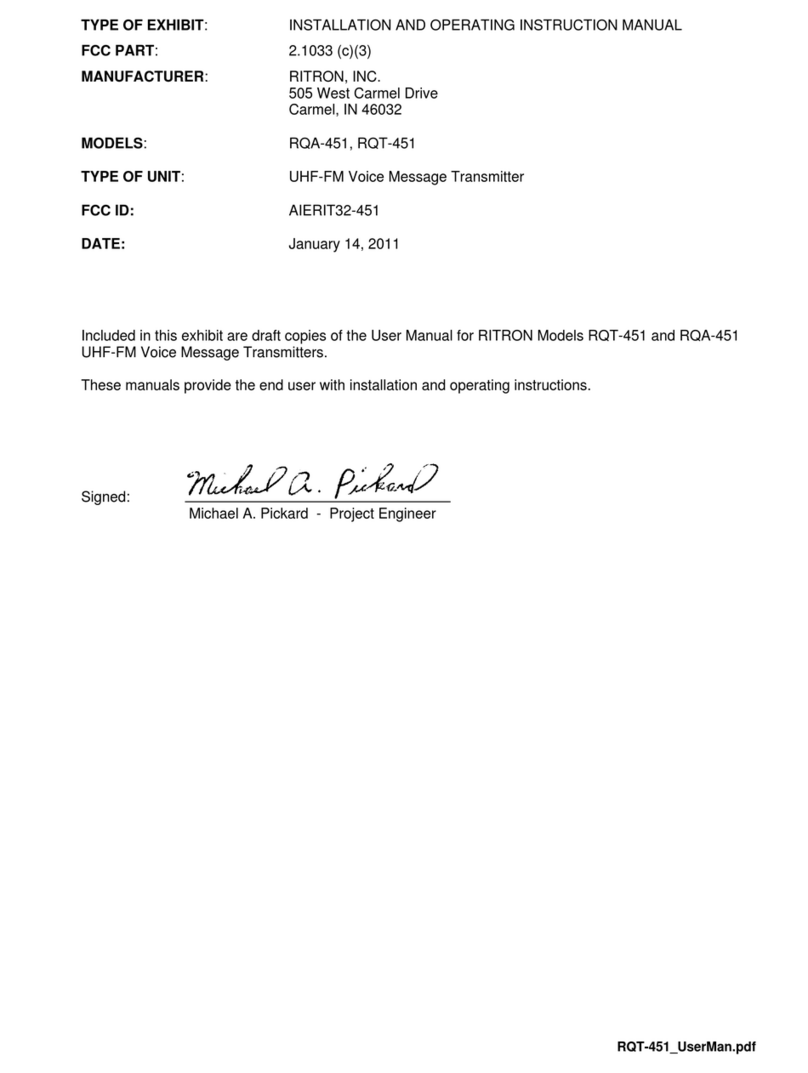
Ritron
Ritron Quick Talk RQA-451 User manual
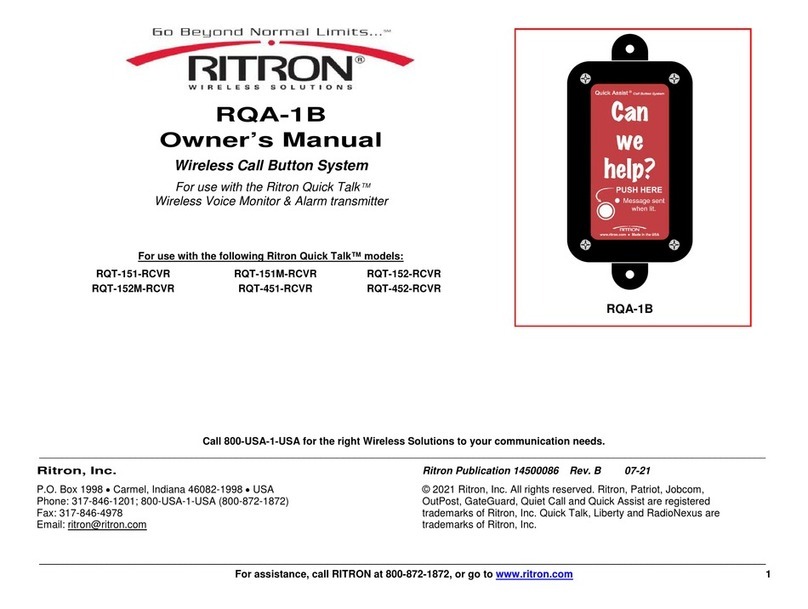
Ritron
Ritron RQA-1B User manual
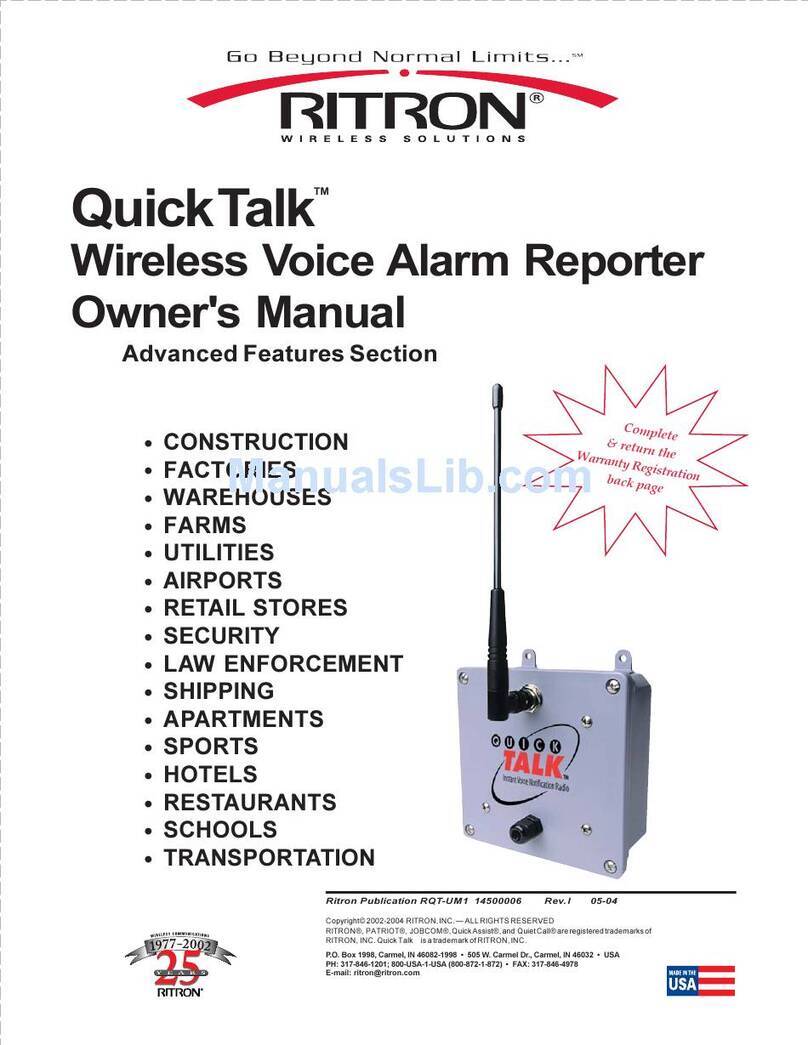
Ritron
Ritron Quick Talk RQT-150 User manual
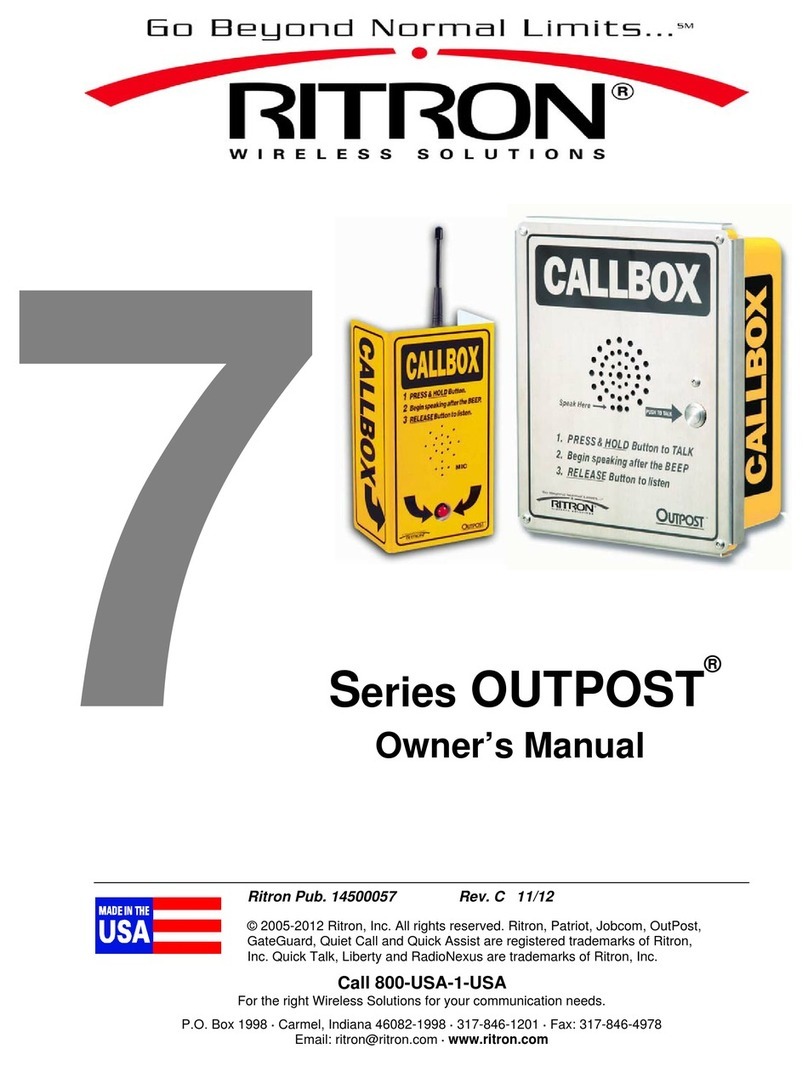
Ritron
Ritron OUTPOST Series User manual

Ritron
Ritron OUTPOST Series User manual

Ritron
Ritron Quick Talk RQT User manual
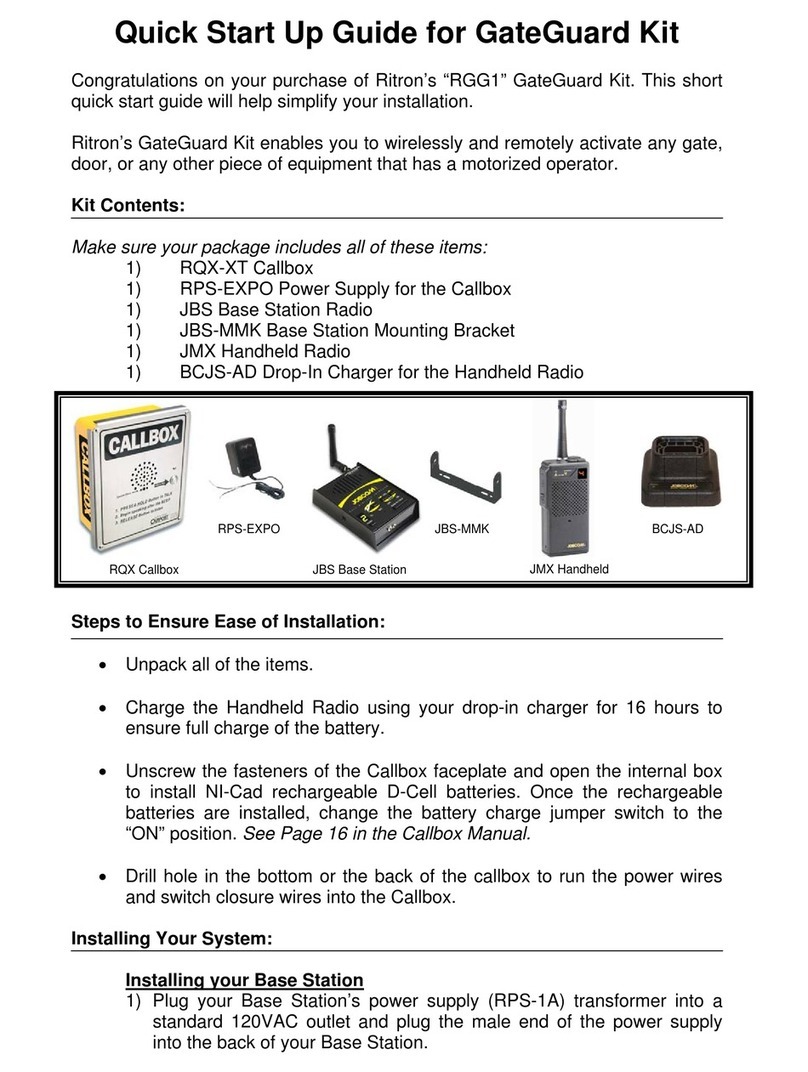
Ritron
Ritron RGG1 User manual
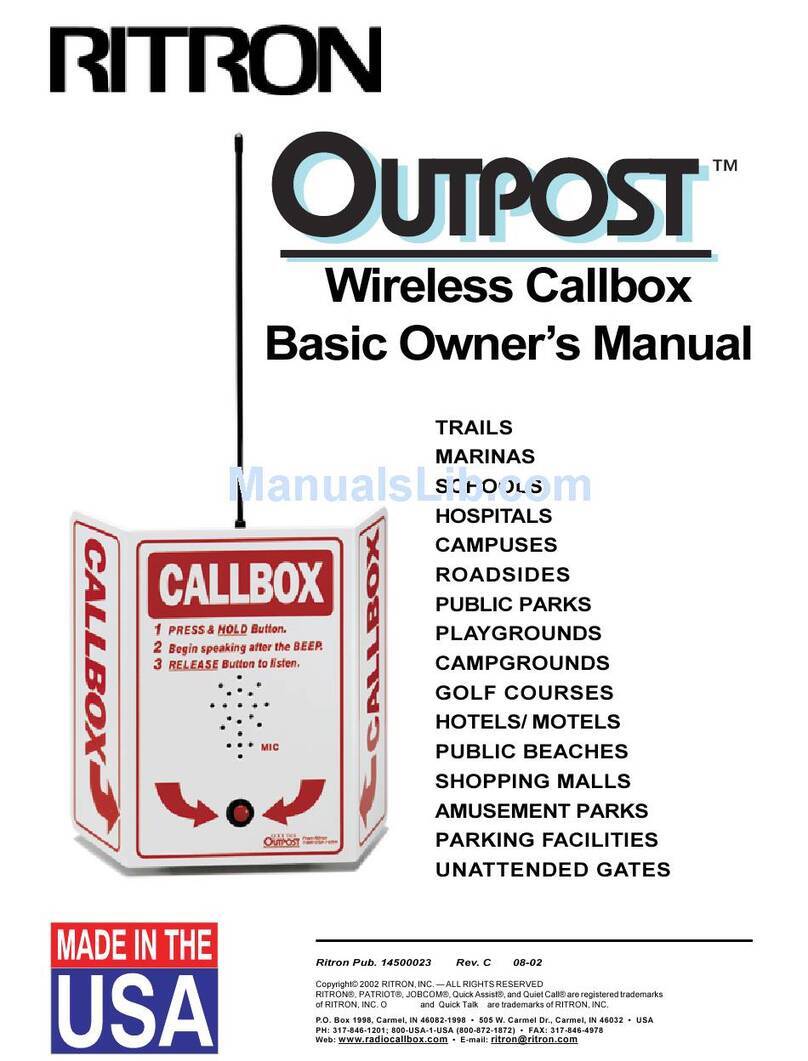
Ritron
Ritron Outpost RQX-150 Installation and service instructions
Popular Security System manuals by other brands
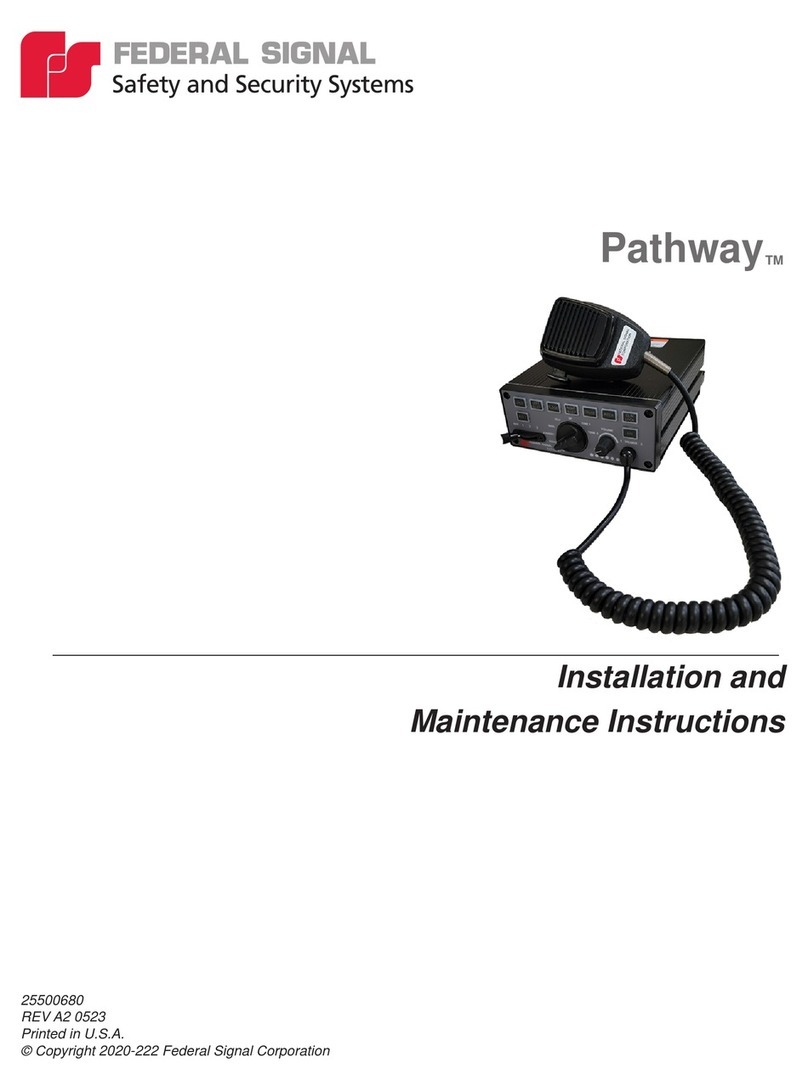
Federal Signal Corporation
Federal Signal Corporation Pathway Installation and maintenance instructions
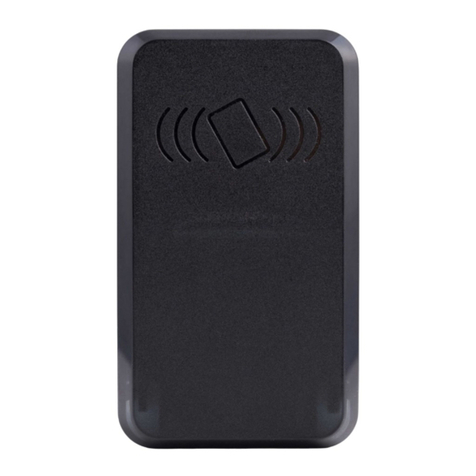
Integra
Integra BCR-S Mini G2 installation manual
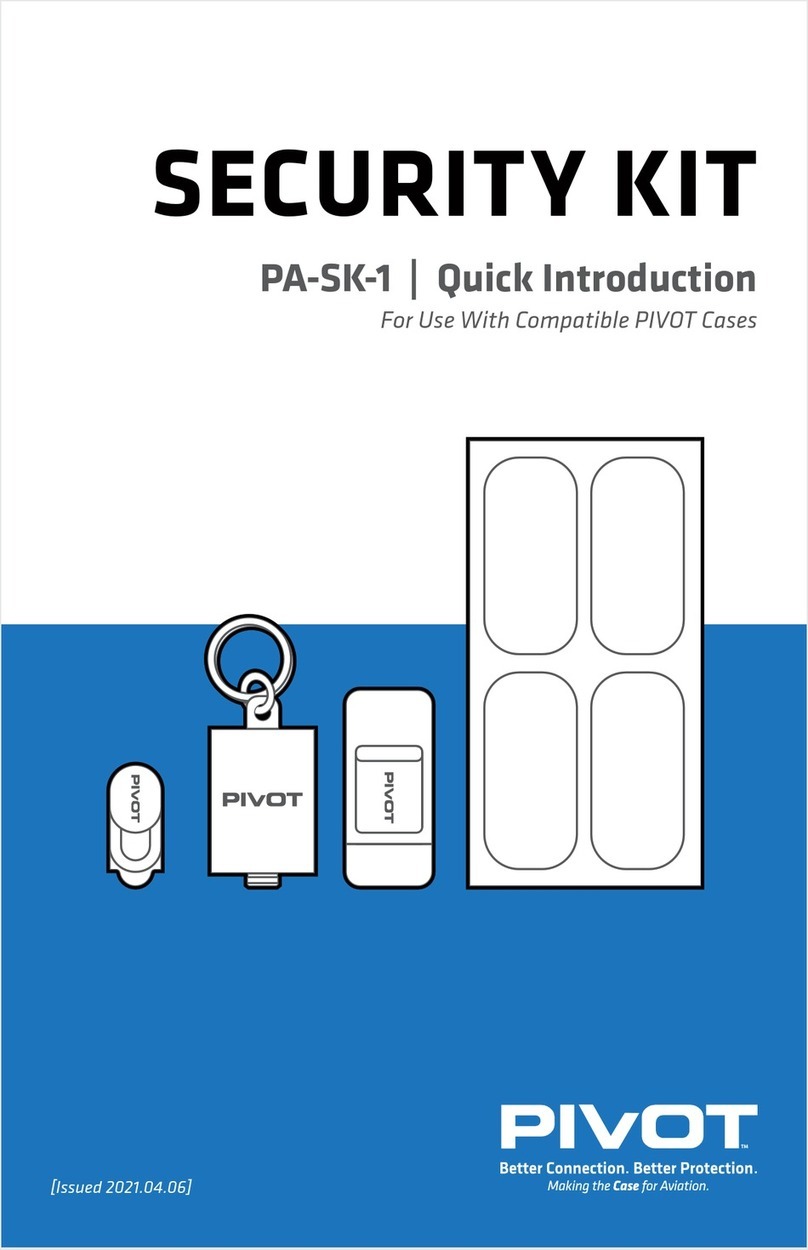
Pivot
Pivot PA-SK1 QUICK INFO
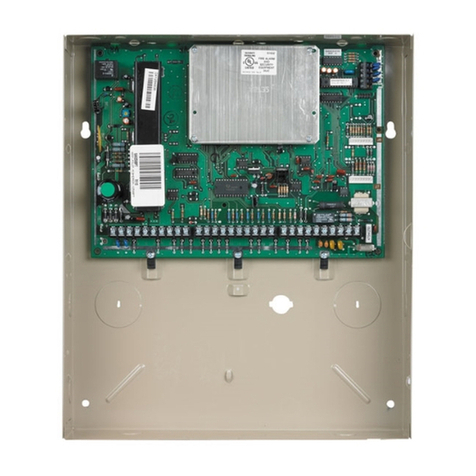
Honeywell
Honeywell Ademco VISTA-50P Installation and setup guide
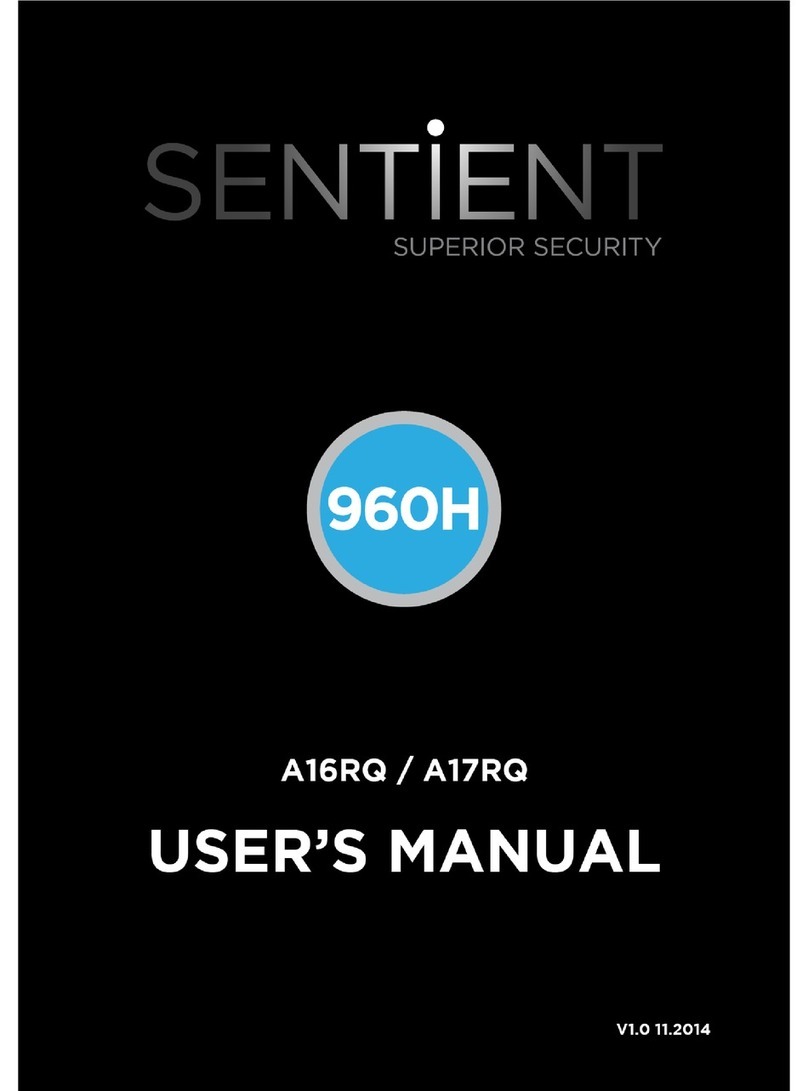
Sentient
Sentient A17RQ user manual
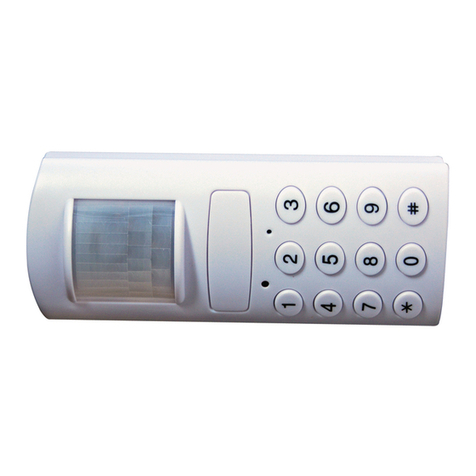
ELBRO
ELBRO EAB01 operating instructions
